Downloads
Models for the REFLEX XTR² Model Flight Simulator
The models are optimized for REFLEX XTR² version 5.09 and newer!
The new installers work for these new REFLEX XTR² versions only, and only under MS Windows 7 SP1, 8.1, 10, and 11! The latest version of REFLEX XTR² can be downloaded and tried for up to 14 days for free. A license key can be purchased in a web shop.
The installers should be downloaded into a suitable folder in the first place!
In a pinch, they can be moved to a different folder after downloading but before
installing. Models and sceneries are stored in subfolders of
C:\ProgramData\REFLEX\Simulator\
You may create a new folder, for instance
C:\ProgramData\REFLEX\Installers\
You may as well use your download folder, but then please don't move or delete
the installers!
They can be re-executed later to modify the model installations! There are several versions of nearly every model, and you won't need all of them at once. Hence you may delete some versions of a model and install others – just with the model's installer.
The installers can be found in a program menu! (That's why they must be
kept in the folder from where they have been executed for the first time;
hence download into a suitable folder in the first place!)
In MS Windows 7, you'll find the start menu entries in Programs/REFLEX/Models.
In MS Windows 10 and 11, they clutter up the REFLEX menu entry, but in Windows 10
you can render them neatly accessible in the task bar:
- Right-click on a blank area of the taskbar.
- Select Toolbars, New Toolbar...
- Navigate to the folder C:\ProgramData\Microsoft\Windows\Start Menu\Programs
- Click on the folder REFLEX and then click "Select Folder".
On the right-hand side in the taskbar appears REFLEX», and clicking on
that » will show the submenu Models. (No joy in Windows 11.)
Each installer contains model definitions (except for models without shape), model parameters, some of them special drive sounds, a text (German and English) with some notes, and many of them even demo flights.
Several installers additionally offer suitable sceneries for download and install. These sceneries come from different authors and servers; this is only a service to make installing them more convenient.
Parkflyers and Electric Gliders for REFLEX XTR²
I personally developed and tested the following models for REFLEX XTR². They are very realistic.
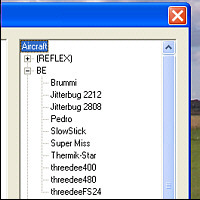
The definition files of my REFLEX models are stored in own subdirectories
(folders), together with a link to my REFLEX web page. The (in this section)
following models, and the demo flights belonging to them, are all included in
an installer. You can simply run it and select models to install. There will be
links to the model descriptions in the 'REFLEX' program menu under 'models'!
>download package installer
(--, 1970-01-01, 7966)
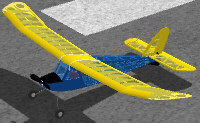
Brummi by Multiplex®, rudder-and-elevator parkflyer. Very docile, perfect for
beginners, but great fun in thermalling, too. Different drive variants
included. Please read the text file belonging to the model (Brummi.txt)!
>download installer
(--, 1970-01-01, 4828)
>description in German
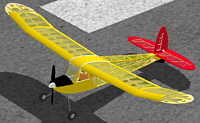
Miss 2 by Scorpio®. Very similar to Brummi, but stronger drive and smaller
rudder and elevator. Therefore even better for beginners? Different drive
variants included. Please read the text file belonging to the model
(Miss2.txt)!
>download installer
(--, 1970-01-01, 2595)
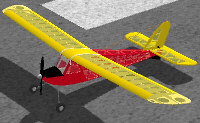
Super Miss by Scorpio®, Ripmax® or Hobby Lobby®, the 'fast sister' of Brummi.
As well suited to thermalling, but even better with strong motor and ailerons.
Please read the text file belonging to the model (Super Miss.txt)!
>download installer
(--, 1970-01-01, 3086)
>description in German
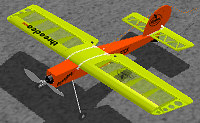
threedee400 by Scorpio®, Ripmax® or Hobby Lobby®, good aerobatic
sports parkflyer. No 3D at all, but - as any stick type model - superb classic
basic trainer with fast roll response and well behaved. Different drive
variants included. Please read the text file belonging to the model
(threedee400.txt)!
>download installer
(--, 1970-01-01, 3925)
>description in German
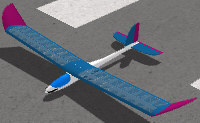
Pedro by Graupner®, rudder-and-elevator beginners model and electric
motorglider. Easy to handle, well behaved and surprisingly good thermalling
performance. Please read the text file belonging to the model (Pedro.txt)!
>download installer
(--, 1970-01-01, 4185)
>description in German
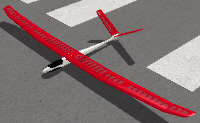
Thermik Star by CHK, nice thermal glider with ailerons. As unpowered glider or
with electric drive for climb to thermal altitude. Easy to handle, well behaved
and very good thermalling performance. Please read the document belonging to
the model (Thermik-Star.pdf)!
>download installer
(--, 1970-01-01, 5290)
>description in German
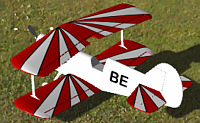
Jitterbug by Dave Szuter, kit by FlyingHobbies, aerobatic parkflyer. Graceful
like a classic biplane, lightweight and gentle like a slowflyer, but strong and
agile like a 3D machine, too. Please read the text file belonging to the model
(Jitterbug.txt)!
>download installer
(--, 1970-01-01, 3562)
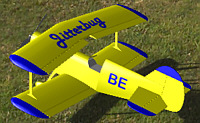
Jitterbug in red/white or yellow/blue trim, the latter also with supporting
skids under the lower wingtips. With an extremely strong AXI drive or a still
quite sufficient one, or with the 'original' Hacker B20-15L with 4:1 gear.
>download see above
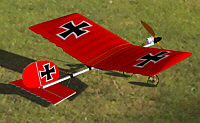
Slow Stick by GWS, rudder-and-elevator slowflyer. Very docile, perfect for
beginners, also something of a cult model in US and UK. Please read the text
file belonging to the model (SlowStick.txt)!
>download installer
(--, 1970-01-01, 3343)
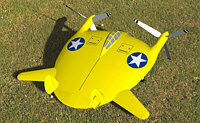
Vought V-173 'Flying Pancake' or 'Flying Flapjack' as a model. Unusual
configuration, but quite easy to handle. Different parameter sets for testing.
Please read the text file belonging to the model (V-173.txt)!
>download installer
(--, 1970-01-01, 3498)
Kazmirski Models for REFLEX XTR²
Ed Kazmirski was the first (1960) model aerobatics world champion with his Orion, which became nearly as world-famous as later his Taurus (1962). Known world-wide is also the trainer Tauri (1963), but not his last competition models Taurus 2 (1964) and Simla (1965). It is interesting to reconstruct and understand the development of those models. Please read the documents belonging to the models, either just here as a pdf file (see below next to the models) or after installation! Links to these comprehensive descriptions will then be found in the menu 'Programs-REFLEX-models'. Demo flights (hit F9 in REFLEX) will show typical flight behavior.
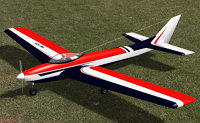 Simla was Kazmirski's last model, really big (102 in wingspan, later
95 in) but lightweight, kind of an aerobatic motorglider looking impressive
in the air. Many versions, also with modern drives; description either here
(Simla.pdf,
--) or after installation!
Including demo flight (hit F9 in REFLEX).
Simla was Kazmirski's last model, really big (102 in wingspan, later
95 in) but lightweight, kind of an aerobatic motorglider looking impressive
in the air. Many versions, also with modern drives; description either here
(Simla.pdf,
--) or after installation!
Including demo flight (hit F9 in REFLEX).
>download package installer
(--, 1970-01-01, 3087)
>video of the demo flight (with comments) on YouTube
>HD video of the demo flight (without comments) on YouTube
Das Ugly Stik for REFLEX XTR²
Das Ugly Stik by Phil Kraft, enhanced by George Walker, kit by Jim Jensen. Aerobatic sports model, a great classic, 40th-anniversary (and meanwhile also 50th-anniversary) edition (2006/2016) as REFLEX XTR² model. The model is not only the intermediate stage between trainer and aerobat but can fill all three roles, depending on engine power and control setup. Please read the paper belonging to the model, either here (UglyStik.pdf, --) or after installation! A link to this comprehensive description will be found in the menu 'Programs-REFLEX-models'. Demo flights (hit F9 in REFLEX) will show typical flight behavior.
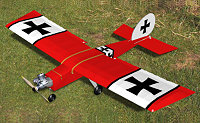 Das Ugly Stik - mild or wild. Made up like a German WWI fighter, a .60 glow
engine and big control throws make it a moderately 'wild' aerobat.
Das Ugly Stik - mild or wild. Made up like a German WWI fighter, a .60 glow
engine and big control throws make it a moderately 'wild' aerobat.
>download package installer
(--, 1970-01-01, 5645)
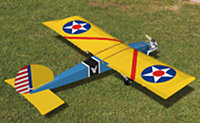 And made up like an American WWII trainer, a .45 glow engine and small control
throws make it a more 'mild' trainer.
And made up like an American WWII trainer, a .45 glow engine and small control
throws make it a more 'mild' trainer.
>download the complete Ugly Stik package, see above
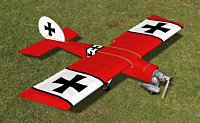 Das Ugly Stik, also as a true classical pattern model with a straight wing.
With a powerful .60 two-stroke engine from the 1970s actually a 'hot rod'.
Another variant has the engine slanted ('hot rod 2'), and yet another one
has really drooping, that is anhedral wings ('hot rod anhedral').
Das Ugly Stik, also as a true classical pattern model with a straight wing.
With a powerful .60 two-stroke engine from the 1970s actually a 'hot rod'.
Another variant has the engine slanted ('hot rod 2'), and yet another one
has really drooping, that is anhedral wings ('hot rod anhedral').
>download the complete Ugly Stik package, see above
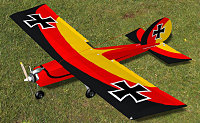 Das Ugly Stik, still a very good sports model, additionally in a modern German
patriot skin. With the Graupner/O.S. .30 'rotary' engine (system NSU/Wankel) even
"wilder" than with the old .60 two-stroke engine.
Das Ugly Stik, still a very good sports model, additionally in a modern German
patriot skin. With the Graupner/O.S. .30 'rotary' engine (system NSU/Wankel) even
"wilder" than with the old .60 two-stroke engine.
>download the complete Ugly Stik package, see above
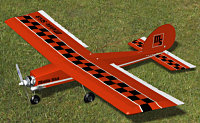 Middle Stick, which Graupner used to introduce the .30 rotary engine in 1970.
Because the first version of the engine was weak, this model has a 'middle'
setup.
Middle Stick, which Graupner used to introduce the .30 rotary engine in 1970.
Because the first version of the engine was weak, this model has a 'middle'
setup.
>download the complete Ugly Stik package, see above
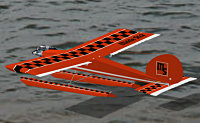 Middle Stick on floats, not with the rotary engine but with a conventional .40
glow engine, which is better suited in this case.
Middle Stick on floats, not with the rotary engine but with a conventional .40
glow engine, which is better suited in this case.
>download the complete Ugly Stik package, see above
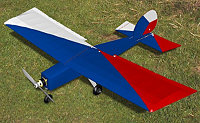 Das Ugly Stik, as ancestor of all stick models really modern, finally in a skin
alluding to the Czech flag. With a ModelMotors AXi 4120 'electric' outrunner
motor and a LiPo battery just as well "wilder" than with the old
.60 two-stroke engine.
Das Ugly Stik, as ancestor of all stick models really modern, finally in a skin
alluding to the Czech flag. With a ModelMotors AXi 4120 'electric' outrunner
motor and a LiPo battery just as well "wilder" than with the old
.60 two-stroke engine.
>download the complete Ugly Stik package, see above
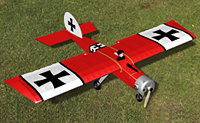 Das Ugly Stik, 'original' as described by Phil Kraft in his 1966 Grid Leaks
magazine article, with straight wing without dihedral and with the "frills",
with the power and the control throws of the 'mild' version.
You may get the original article with my annotations in the paper
mentioned above (no longer in a separate pdf file), here
(UglyStik.pdf,
--) or after installation.
Das Ugly Stik, 'original' as described by Phil Kraft in his 1966 Grid Leaks
magazine article, with straight wing without dihedral and with the "frills",
with the power and the control throws of the 'mild' version.
You may get the original article with my annotations in the paper
mentioned above (no longer in a separate pdf file), here
(UglyStik.pdf,
--) or after installation.
>download the complete Ugly Stik package, see above
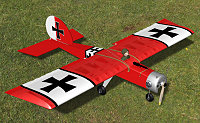 Das Ugly Stik, 'prototype' built by George Walker as embellishment
of the test bed. With translucent wing, bigger and more forward vertical
tail, and with the power and the control throws of the 'wild' version.
And Phil Kraft's 'prototype 2', built by Dick Kidd, with the power and
the control throws of the 'wild' version.
Das Ugly Stik, 'prototype' built by George Walker as embellishment
of the test bed. With translucent wing, bigger and more forward vertical
tail, and with the power and the control throws of the 'wild' version.
And Phil Kraft's 'prototype 2', built by Dick Kidd, with the power and
the control throws of the 'wild' version.
>download the complete Ugly Stik package, see above
>HD video of the demo flight on YouTube
>8mm movie of the 1966 original maiden flight on YouTube
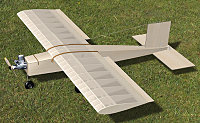 Square Stik, Nasti-Stik, or 'Box-Fli', the original test bed mentioned
by Phil Kraft in his 1966 Grid Leaks magazine article, with straight
and square wing and tail, without any "frills", and in pure
balsa-silk-and-dope look.
With the power and the control throws of the 'wild' version.
A demo flight (hit F9 in REFLEX) is named 'Box-Fli'.
Square Stik, Nasti-Stik, or 'Box-Fli', the original test bed mentioned
by Phil Kraft in his 1966 Grid Leaks magazine article, with straight
and square wing and tail, without any "frills", and in pure
balsa-silk-and-dope look.
With the power and the control throws of the 'wild' version.
A demo flight (hit F9 in REFLEX) is named 'Box-Fli'.
>download the complete Ugly Stik package, see above
>HD video of the demo flight on YouTube
Kwik-Fli for REFLEX XTR²
Kwik-Fli Mk III by Phil Kraft, 1967 aerobatic world-champion model. A great classic, 40th-anniversary (2007) edition as REFLEX XTR² model. The model is still up-to-date as a most basic, typical design of a classic pattern model, today more called a sport model. Please read the document belonging to the model, either here (KwikFli.pdf, --) or after installation! A link to this comprehensive description will be found in the menu 'Programs-REFLEX-models'. Demo flights (hit F9 in REFLEX, 'Kwik-Fli...') will show typical flight behavior.
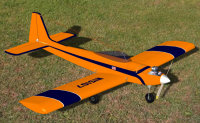
Kwik-Fli Mk III, in the original paint scheme, with a .60 glow engine without
muffler. With center-of-gravity and decalage as per the plans as a stable
flying 'original', alternatively with more back c/g and almost no decalage as a
more neutral and 'crisp' setup.
>download package installer
(--, 1970-01-01, 4158)
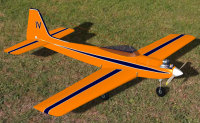
Kwik-Fli Mark IV, meaning Mk III with tapered wing. With not much decalage as
nearly neutral version 'original'. Purpose of the modifikation was better flick
ability, which is really better only in the 'crisp' setup. The slightly
different paint scheme was traditional as well.
>download the complete Kwik-Fli package, see above
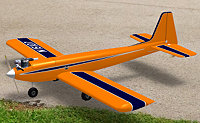
Kwik-Fli Mk III as still flown by Phil Kraft around 1970. With more powerful
engine with muffler as well as retractable landing gear, hence noticeably more
weight. As 'retracts' version balanced neutrally since it's considerably faster
and more agile than the 1967 World Champonship version.
>download the complete Kwik-Fli package, see above
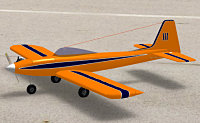
Kwik-Fli Mk III, only for comparison also with more powerful engine and
retractable landing gear as 'retracts' version, but only slightly more weight
than the original version. Almost as neutral and fast flight characteristics as
later pattern models.
>download the complete Kwik-Fli package, see above
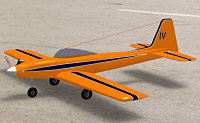
Kwik-Fli Mk IV as well with slightly more weight, more powerful engine and
retractable landing gear as version 'retracts'. Of course even faster and doing
even better flick rolls and spins.
>download the complete Kwik-Fli package, see above
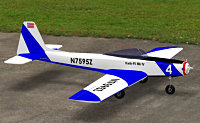
Kwik-Fli Mk IV with retractable landing gear and rotary engine as version
'rotary'. By means of this engine and of reduced fuselage drag, again faster
but still not a "rocket" ship.
>download the complete Kwik-Fli package, see above
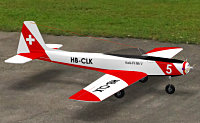
Kwik-Fli Mk V (that's what I call it) with retractable landing gear, rotary
engine, and a thinner wing as version 'rocket'. Now the model is a "rocket" and
flies "ballistic", but thanks to flaps can land like the original version.
>download the complete Kwik-Fli package, see above
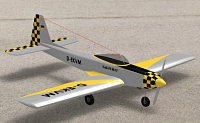
Kwik-Fli Mk IV, with electric drive as version 'electric'. Modern aerobatic
sport model which is able to gracefully fly any classic aerobatic schedule.
>download the complete Kwik-Fli package, see above
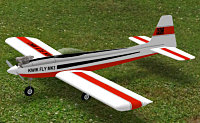
KWIK FLY MK3, the old 'Graupner' version from the 1970s. With more powerful
engine and some more weight than the original.
>download the complete Kwik-Fli package, see above
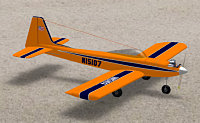
Flea Fli, meaning Mk III scaled down by 0.66 and with a .20 engine, in the
original paint scheme. With not much decalage as nearly neutral version
'original' and as completely neutral version 'crisp'.
>download the complete Kwik-Fli package, see above
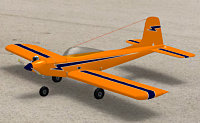
Kwik-Fli Mk II, predecessor of Mark III with the same wing. Shorter tail moment
arm and smaller vertical tail and elevator show in the flight behavior. With a
small decalage stable balanced like the original, with a '.45' engine and a
'.60'. The paint scheme was normal for the model.
>download the complete Kwik-Fli package, see above
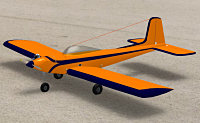
Kwik-Fli Mk I, first version of all with bigger wing and more weight. Same wing
loading, but rather short tail moment arm and small vertical tail and elevator
still don't give optimum flight behavior. With a small decalage stable balanced
like the original. The paint scheme was really used for the model.
>download the complete Kwik-Fli package, see above
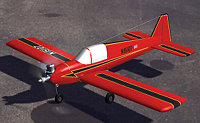
Bar-Fli, alternate model for the World Championships. A bit smaller and lighter
than Mark III, but with the same .60 engine. Therefore more dynamic and better
in wind, in addition to other advantages. With not much decalage as nearly
neutral version 'original' and as completely neutral version 'crisp'.
>download the complete Kwik-Fli package, see above
Brushfire for REFLEX XTR²
Brushfire by Ken Bonnema, pattern competition model, designed 1978. Typical design of a 'ballistic' pattern model, with swept wing and tail and nearly completely symmetric. Therefore very smooth and neutral in all aerobatic maneuvers. Please read the document belonging to the model, either here (Brushfire.pdf, --) or after installation! A link to this comprehensive description will be found in the menu 'Programs-REFLEX-models'. A demo flight (hit F9 in REFLEX) will show typical flight behavior.
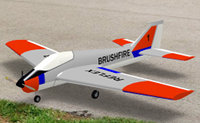
Brushfire in the paint scheme of the very first model, with a .61 glow engine
with tuned pipe outside the fuselage. With maneuver flaps, full-flying
stabilizer (stabilator) and normal 9.25 lbs weight. Trimmed neutrally as the
very well flying 'original 1' version.
>download package installer
(--, 1970-01-01, 3394)
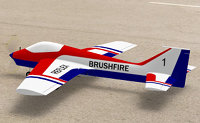
Brushfire in the paint scheme of the second model ever built, as well with the
.61 side-exhaust glow engine with tuned pipe outside the fuselage. With
maneuver flaps, conventional elevators and the normal 9.25 lbs weight. Trimmed
as recommended in the plan, as differently but equally well flying 'original 2'
version.
>download the complete Brushfire package, see above
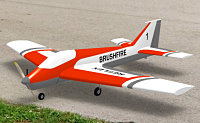
Brushfire in the paint scheme of the second model ever built, but in wrong
colors. As well with the .61 side-exhaust glow engine with tuned pipe outside
the fuselage. With 11 lbs weight as still 'ballistic' flying 'heavy'
version.
>download the complete Brushfire package, see above
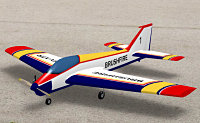
Brushfire in a colorful paint scheme, as well with the .61 side-exhaust glow
engine with tuned pipe outside the fuselage. With low 8 lbs weight as also
slowly very well flying 'lightweight' version.
>download the complete Brushfire package, see above
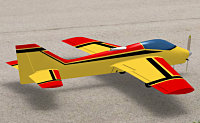
Brushfire in a more modern paint scheme, as well with the low 8 lbs weight and
the .61 glow engine, but a rear-exhaust and both engine and tuned pipe inside
the fuselage. Now as 'enhanced' version even 95 mph fast instead of 'only'
90 mph.
>download the complete Brushfire package, see above
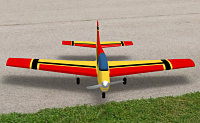
Brushfire again in this more modern paint scheme, but with an electric drive
as version 'electric 1'. Only slightly more weight and less speed, but much
thrust.
>download the complete Brushfire package, see above
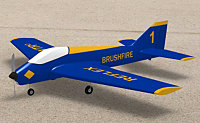
Brushfire in a paint scheme similar to that of the Blue Angels as version
'electric 2'. With bigger battery a bit more weight, but still much thrust.
>download the complete Brushfire package, see above
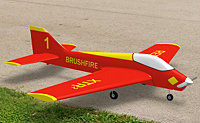
Brushfire again in this paint scheme, but with better visible colors as version
'electric 3'. Good tradeoff between versions 1 and 2 in terms of weight and
thrust. Also with maneuver flaps.
>download the complete Brushfire package, see above
Telemaster for REFLEX XTR²
Telemaster by Karl-Heinz Denzin (rights Alexander Engel), utility and trainer model, designed about 1967/68. World-known and used not only as a trainer but also to drop candies, as a camera carrier, or as a tug. Flies slowly and absolutely well-behaved, hence suitable for beginners. Typically in two or more sizes (71" and 95"). Please read the document belonging to the model, either here (Telemaster.pdf, --) or after installation! A link to this comprehensive description will be found in the menu 'Programs-REFLEX-models'. Demo flights (hit F9 in REFLEX, 'Senior Telemaster .60', 'Giant Telemaster 26ccm', and more) will show typical flight behavior.
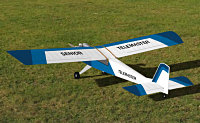 Senior Telemaster (95 in wingspan) with a .60 glow engine with muffler.
At the normal 10 lb weight actually over-powered, but good for airwork.
Ailerons acting as flaperons in the 'Senior .60 glow' version, separate flaps
for comparison in the 'Senior .60 glow flaps' variant, and 5 lb payload
in the 'Senior .60 glow flaps payload' variant.
Senior Telemaster (95 in wingspan) with a .60 glow engine with muffler.
At the normal 10 lb weight actually over-powered, but good for airwork.
Ailerons acting as flaperons in the 'Senior .60 glow' version, separate flaps
for comparison in the 'Senior .60 glow flaps' variant, and 5 lb payload
in the 'Senior .60 glow flaps payload' variant.
>download package installer
(--, 1970-01-01, 4369)
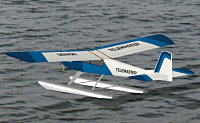 Senior Telemaster (95 in wingspan) on floats as version 'Senior .60 glow
flaps floats'. Flies really nice, with a .60 glow engine and 11.5 lb weight.
Senior Telemaster (95 in wingspan) on floats as version 'Senior .60 glow
flaps floats'. Flies really nice, with a .60 glow engine and 11.5 lb weight.
>download the complete Telemaster package, see above
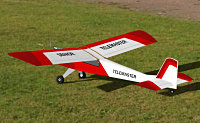 Senior Telemaster (95 in wingspan) with a .45 glow engine with muffler.
Flies beautifully with it at the normal 10 lb weight. Ailerons acting as
flaperons in the 'Senior .45 glow' version, separate flaps for comparison in
the 'Senior .45 glow flaps' variant, and a rotating-sleeve four-stroke glow
engine in the 'Senior RCV 58-CD flaps' variant.
Senior Telemaster (95 in wingspan) with a .45 glow engine with muffler.
Flies beautifully with it at the normal 10 lb weight. Ailerons acting as
flaperons in the 'Senior .45 glow' version, separate flaps for comparison in
the 'Senior .45 glow flaps' variant, and a rotating-sleeve four-stroke glow
engine in the 'Senior RCV 58-CD flaps' variant.
>download the complete Telemaster package, see above
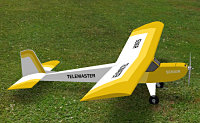 Senior Telemaster (95 in wingspan) with an AXI 4120/18 motor, 14x10"
propeller, and 5000 mAh 5s LiPo battery. At least for such models, the
electric drive is better than the glow engine. Ailerons acting as flaperons
in the 'Senior electric' version, separate flaps for comparison in the 'Senior
electric flaps' variant, and a 6000 mAh 4s battery in the 'Senior electric
flaps duration' variant.
Senior Telemaster (95 in wingspan) with an AXI 4120/18 motor, 14x10"
propeller, and 5000 mAh 5s LiPo battery. At least for such models, the
electric drive is better than the glow engine. Ailerons acting as flaperons
in the 'Senior electric' version, separate flaps for comparison in the 'Senior
electric flaps' variant, and a 6000 mAh 4s battery in the 'Senior electric
flaps duration' variant.
>download the complete Telemaster package, see above
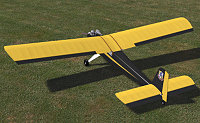 Senior Telemaster (95 in wingspan) with a .60 glow engine with muffler.
Radio Control Modeler magazine built and pictured the model with this paint
scheme in 1975. They specified 104 oz all-up weight. Ailerons acting as
flaperons in this 'Senior .60 RCM 1975' version as well as in the 'Senior
.20 RCM 1975' variant with a .20 glow engine and 92 oz weight.
Senior Telemaster (95 in wingspan) with a .60 glow engine with muffler.
Radio Control Modeler magazine built and pictured the model with this paint
scheme in 1975. They specified 104 oz all-up weight. Ailerons acting as
flaperons in this 'Senior .60 RCM 1975' version as well as in the 'Senior
.20 RCM 1975' variant with a .20 glow engine and 92 oz weight.
>download the complete Telemaster package, see above
>HD video of the demo flight on YouTube
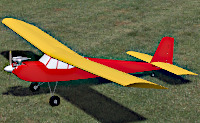 Senior Telemaster (95 in wingspan) with a .61 glow engine with muffler.
That's how the model was produced by Engel in Germany and pictured on the
kit box from 1970 on.
Barn-door ailerons, and here big flaps for demonstration.
'Senior .61 Engel flaps' with 6.5 lbs assumed all-up weight, 11 lbs with 'payload'.
'Senior .35 Engel flaps' with a .35 glow engine and 'Senior .19 Engel flaps' with a .19 glow engine.
'Senior 2820-14 Engel flaps' with electric motor and 6.5 lbs assumed all-up weight,
'duration' with bigger battery.
Senior Telemaster (95 in wingspan) with a .61 glow engine with muffler.
That's how the model was produced by Engel in Germany and pictured on the
kit box from 1970 on.
Barn-door ailerons, and here big flaps for demonstration.
'Senior .61 Engel flaps' with 6.5 lbs assumed all-up weight, 11 lbs with 'payload'.
'Senior .35 Engel flaps' with a .35 glow engine and 'Senior .19 Engel flaps' with a .19 glow engine.
'Senior 2820-14 Engel flaps' with electric motor and 6.5 lbs assumed all-up weight,
'duration' with bigger battery.
>download the complete Telemaster package, see above
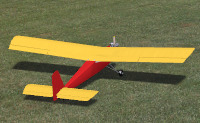 Original Telemaster (71 in wingspan) by Engel. The designer Karl-Heinz Denzin meant it
as a trainer with rudder, elevator, and (barn-door) ailerons, even in 1968!
Here as well in the red/yellow paint scheme, appropriate to a trainer.
Original Telemaster (71 in wingspan) by Engel. The designer Karl-Heinz Denzin meant it
as a trainer with rudder, elevator, and (barn-door) ailerons, even in 1968!
Here as well in the red/yellow paint scheme, appropriate to a trainer.
'Original .30 Engel' with adequate .30 glow engine
and ambitious 4.4 lbs all-up weight, for comparison
'Original .35 Engel' with very powerful .35 glow engine
and realistic 5.5 lbs all-up weight.
>download the complete Telemaster package, see above
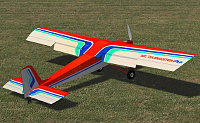 Senior Telemaster Plus (95 in wingspan) with 360 kv
outrunner motor, 17x10" propeller and 5000 mAh 5s LiPo battery
('Senior Plus 360kv 17x10E 5sLiPo').
Two additional drive variants with 17x12" propeller and 5000 mAh
4s LiPo ('Senior Plus 360kv 17x12E 4sLiPo') or 5s LiFePo ('Senior
Plus 360kv 17x12E 5sLiFePo') battery. More than 10 lbs weight.
First in the line of new V2 (version 2) Telemaster models with more
"modern" flight characteristics.
REFLEX model rendering my real model (see own
review page)
including sound.
Senior Telemaster Plus (95 in wingspan) with 360 kv
outrunner motor, 17x10" propeller and 5000 mAh 5s LiPo battery
('Senior Plus 360kv 17x10E 5sLiPo').
Two additional drive variants with 17x12" propeller and 5000 mAh
4s LiPo ('Senior Plus 360kv 17x12E 4sLiPo') or 5s LiFePo ('Senior
Plus 360kv 17x12E 5sLiFePo') battery. More than 10 lbs weight.
First in the line of new V2 (version 2) Telemaster models with more
"modern" flight characteristics.
REFLEX model rendering my real model (see own
review page)
including sound.
>download the complete Telemaster package, see above
>HD video of the demo flight on YouTube
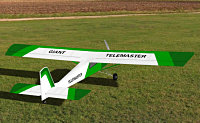 Giant Telemaster (143 in wingspan), big ailerons and separate flaps,
same wing loading as the Senior. With an AXI 5330/24 motor, 20x11" propeller
and 4000 mAh 10s LiPo battery in the 'Giant electric flaps' version,
with a Zenoah ZG 26 gas engine in the 'Giant 26 ccm gas flaps' variant,
both with 23 lbs weight. And with a Saito four-stroke glow engine
and 21.4 lbs weight in the 'Giant FA 125A flaps' variant.
Giant Telemaster (143 in wingspan), big ailerons and separate flaps,
same wing loading as the Senior. With an AXI 5330/24 motor, 20x11" propeller
and 4000 mAh 10s LiPo battery in the 'Giant electric flaps' version,
with a Zenoah ZG 26 gas engine in the 'Giant 26 ccm gas flaps' variant,
both with 23 lbs weight. And with a Saito four-stroke glow engine
and 21.4 lbs weight in the 'Giant FA 125A flaps' variant.
>download the complete Telemaster package, see above
>video of the demo flight (with comments) on YouTube
>HD video of the demo flight (without comments) on YouTube
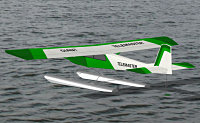 Giant Telemaster (143 in wingspan) on floats as version
'Giant 26 ccm gas flaps floats'. Flies even better than Senior,
with 26 ccm gas engine and 26.75 lb weight.
Giant Telemaster (143 in wingspan) on floats as version
'Giant 26 ccm gas flaps floats'. Flies even better than Senior,
with 26 ccm gas engine and 26.75 lb weight.
>download the complete Telemaster package, see above
>HD video of the demo flight on YouTube

Documents (in English, with German originals) on the history of the
Telemaster models:
>Telemaster page from the 1973 Engel catalog
(--, 1970-01-01, 2113)
>Plan, instructions, bill of material, original Telemaster
(--, 1970-01-01, 4992)
>Plan, instructions, bill of material, Senior Telemaster
(--, 1970-01-01, 8080)
>Nylon-fabric/dope 1968 catalog pages
(--, 1970-01-01, 1242)
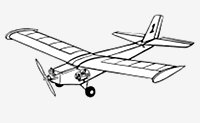
Complementary documents (in English, with German originals) on the
history of the Telemaster models:
>beginners model page from the 1967 Engel catalog
(--, 1970-01-01, 1298)
>engines/accessories 1968 catalog pages
(--, 1970-01-01, 1524)
>glues/x-acto 1968 catalog pages
(--, 1970-01-01, 1739)
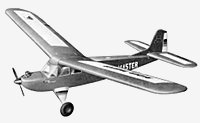
Complementary documents (in English, with German originals) on the
history of the Telemaster models:
>Radar-Master page from the 1967 Engel catalog
(--, 1970-01-01, 2271)
>PILOT/Radarmaster page from the 1968 catalog
(--, 1970-01-01, 1465)
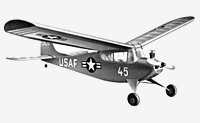
Complementary documents (in English, with German originals) on the
history of the Telemaster models:
>PILOT page from the 1967 Engel catalog
(--, 1970-01-01, 1523)
Learn Model Flying with REFLEX XTR²
On this subject, "Learn model flying with a simulator and especially with REFLEX XTR²", I have compiled frequently asked questions and my answers on them in a quite long text file. It was meant for powered airplane models in the first place, but I've later added my experiences with helicopter flying.
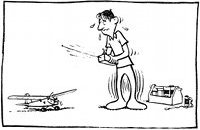 Fear of Flying? Don't fret, there's the simulator! But how
does it work? What to learn with which models? How about landing gear, flaps,
side thrust? (Basically about powered model airplanes
but model helicopters as well.)
Fear of Flying? Don't fret, there's the simulator! But how
does it work? What to learn with which models? How about landing gear, flaps,
side thrust? (Basically about powered model airplanes
but model helicopters as well.)
Read/download the illustrated (English) text right here:
>Simulator.pdf
(--, 1970-01-01, 6193)
Mentioned in the text are several models and sceneries which are not included in REFLEX because they stem from independent authors. They are aggregated in one package each for airplanes and helicopters with which they can be downloaded and installed automatically and conveniently. These packages should be downloaded to a folder on your hard disk where they can remain. Installers for models and sceneries will be downloaded to the same folder then. You may run them again later to select different variants of models and sceneries. There are detailed instructions in the last section of the text but also here when you click "download package" (and they are slightly different).
 Installable trainer airplane models and sceneries (with variants):
Installable trainer airplane models and sceneries (with variants):
| GWS Slow Stick | WingMaster | MFC Silbergrube | (both in the picture on the left side) |
| Miss 2 | Telemaster | Fischen im Allgäu | |
| Brummi | Das Ugly Stik | Peenemünde airfield | |
| Super Miss | Kwik Fli | St. Johann im Rosental | |
| Graupner Taxi | Brushfire | Modelcity | |
| Calmato 40 Trainer |
(--, 1970-01-01, 223)
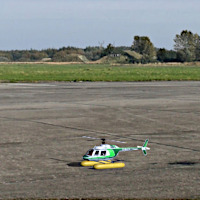 Installable trainer helicopter models and sceneries (with variants):
Installable trainer helicopter models and sceneries (with variants):
| KYOSHO Concept 30 SE | Peenemünde airfield | (both in the picture on the left side) |
| HIROBO Shuttle Plus 30 | MFC Silbergrube | |
| Hughes 500 D Magnum | Fischen im Allgäu | |
| Graupner Star Ranger | Rastede gym | |
| Bell 205 LA County Fire Dept. | ||
| Mil Mi-24C Hind |
(--, 1970-01-01, 168)
The model which I used in the late 1960s when trying to learn model flying is available for the simulator, together with a comprehensive description and demonstration flights - just for nostalgic understanding. The demo flights show typical flight behavior of the three model versions. A version with all controls, flaps, and electric drive is even a modern beginners model.
The comprehensive description (VEBF.pdf, --, in English) discusses the model's behavior by means of the demo flights, goes into design considerations, presents the vintage radio and the vintage engine, and discusses the model's practicability for flying schools (and a modern variant named WingMaster). The model as it was actually outlined by the expert (this variant is named FoolProof here), Graupner Taxi, and Engel Telemaster are compared to my model.
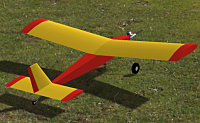 VEBF - Very Easy to Build and Fly. Nowadays, this
beginner model from the late 1960s is an odd thing, but in the simulator it's an
amazing model for rank beginners. Versions with rudder only, additional elevator,
additional ailerons as well as ailerons and flaps.
VEBF - Very Easy to Build and Fly. Nowadays, this
beginner model from the late 1960s is an odd thing, but in the simulator it's an
amazing model for rank beginners. Versions with rudder only, additional elevator,
additional ailerons as well as ailerons and flaps.
>download installer
(--, 1970-01-01, 3897)
Comprehensive description after installation found in the menu
'Programs-REFLEX-models' or here
(VEBF.pdf,
--).
Demo flights named VEBFn, hit F9 in REFLEX, or at YouTube:
VEBF1,
VEBF2,
VEBF3.
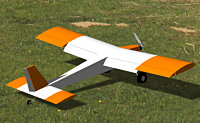 WingMaster is basically a full-fledged, modern version of VEBF with all
controls, flaps, and an electric drive. It's the virtual rendering of a
possible (fictitious) real model which should be a perfect basic trainer
owned by a flying school or instructor.
Explanation in the VEBF description (VEBF.pdf).
WingMaster is basically a full-fledged, modern version of VEBF with all
controls, flaps, and an electric drive. It's the virtual rendering of a
possible (fictitious) real model which should be a perfect basic trainer
owned by a flying school or instructor.
Explanation in the VEBF description (VEBF.pdf).
>download the complete VEBF package, see above
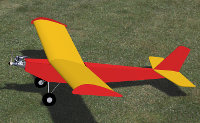 FoolProof is virtually VEBF as it actually should have been, at least
according to the recommendation in the 1967 Engel modeling catalog. As for
VEBF, there are versions with rudder only, additional elevator, and additional
ailerons and flaps.
For comparison with VEBF, explanation in the VEBF description (VEBF.pdf).
FoolProof is virtually VEBF as it actually should have been, at least
according to the recommendation in the 1967 Engel modeling catalog. As for
VEBF, there are versions with rudder only, additional elevator, and additional
ailerons and flaps.
For comparison with VEBF, explanation in the VEBF description (VEBF.pdf).
>download the complete VEBF package, see above
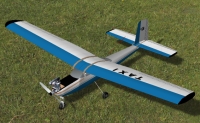 Graupner® Taxi was the popular trainer model from 1966
to the 1980s, a perfect conventional design. The REFLEX model was made by
Bo (Jörgen) Strömberg. One version true to the original
with rudder and elevator and another one even with ailerons and flaps.
For comparison with VEBF, explanation in the VEBF description (VEBF.pdf).
Graupner® Taxi was the popular trainer model from 1966
to the 1980s, a perfect conventional design. The REFLEX model was made by
Bo (Jörgen) Strömberg. One version true to the original
with rudder and elevator and another one even with ailerons and flaps.
For comparison with VEBF, explanation in the VEBF description (VEBF.pdf).
>install with the VEBF installer, see above, or
>install with the Taxi installer, see
further down.
 Engel Telemaster was perhaps the first beginner and trainer model with ailerons
even in 1969. The designer Karl-Heinz Denzin made it unusually big but lightweight
so it carried the heavy R/C equipment of the time and still flew slowly. Otherwise
it's a conventional design and very good-natured.
One lightweight version with good power and a heavier one with very powerful engine.
For comparison with VEBF, explanation in the VEBF description (VEBF.pdf).
Engel Telemaster was perhaps the first beginner and trainer model with ailerons
even in 1969. The designer Karl-Heinz Denzin made it unusually big but lightweight
so it carried the heavy R/C equipment of the time and still flew slowly. Otherwise
it's a conventional design and very good-natured.
One lightweight version with good power and a heavier one with very powerful engine.
For comparison with VEBF, explanation in the VEBF description (VEBF.pdf).
>install with the VEBF installer, see above, or
>install with the Telemaster installer, see
further up.
M.F.I./Boelkow Junior for REFLEX XTR²
M.F.I. MFI-9 or Boelkow Bo 208 respectively, in both cases 'Junior', as a scale model. Quite small, simple, vivid yet honest sports aircraft from the 1960s, even suited for basic aerobatics. Would be an easy scratch-build as a model, which would make a good tug. Please read the document belonging to the model, either here (Junior.pdf, --) or after installation! A link to this comprehensive description will be found in the menu 'Programs-REFLEX-models'. Demo flights (hit F9 in REFLEX, 'Bo 208 Junior' or 'MFI-9 Junior ...') will show typical flight behavior.
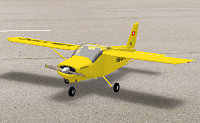
Boelkow Bo 208 A Junior scaled 1:3 (97.5" wing span), loosely rendered after
the nice original HB-UPC. With different gas engines: Zenoah ZG 26 (flying
around), ZG 45 (towing), ZG 62 (brute force).
>download package installer
(--, 1970-01-01, 3950)
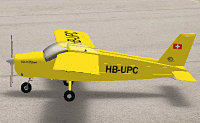
The same scaled 1:3.5 (83.5" wing span): Zenoah ZG 20 (great flyer), ZG 26
(good tug), ZG 38 (very good tug). This model is additionally set up as if it
were towing an MDM-1 Fox glider (please read the document).
>download the complete Junior package, see above
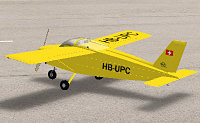
And again scaled 1:2.5 (117" wing span): Zenoah ZG 45 (great flyer), ZG 62
(good tug), ZG 80 (very good tug). An expert version with ZG 45 has more
elevator and flap deflections.
>download the complete Junior package, see above
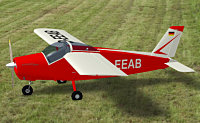
Scaled 1:3 (97.5" wing span) in a matching paint scheme as a tug, with a Saito
FA-300T flat-twin four-stroke glow engine. As well more elevator and flap
deflections.
>download the complete Junior package, see above
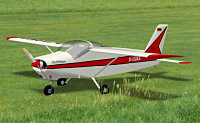
The paint scheme of the first airplanes built in the early 1960s, used for the
'tug-glider combinations' scaled 1:3.5 (83.5" wing span) and for the expert
version scaled 1:2.5 (117" wing span).
>download the complete Junior package, see above
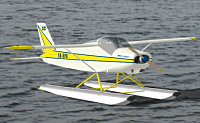
MFI-9 Junior scaled 1:2.5 (117" wing span) with a Zenoah ZG 45 on floats, as in
reality offered by the licensor M.F.I. (not by the licensee Boelkow). In a
suitable scenery the model behaves reasonably realistic on 'water'. For
comparison also scaled 1:3.5 (83.5" wing span).
>download the complete Junior package, see above
(reference to suitable sceneries in the document)
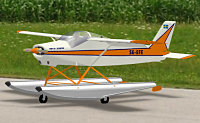
And again scaled 1:2.5 (117" wing span) as amphibious version. Like in reality
this is a makeshift since the amphibious floats must be handled with extreme
care.
>download the complete Junior package, see above
(reference to suitable sceneries in the document)
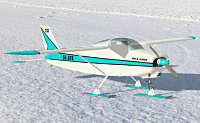
Scaled 1:2.5 (117" wing span) with a Zenoah ZG 45 finally also as a ski
version, in reality as well offered by M.F.I. In a suitable scenery the model
behaves quite realistic on 'snow', except the skis are not moving. For
comparison also scaled 1:3.5 (83.5" wing span).
The position lights will shine in darkness, for instance in the Fischen Moonlight scenery.
>download the complete Junior package, see above
(reference to suitable sceneries in the document)
Bergfalke for REFLEX XTR²
Bergfalke II/55 by Scheibe Aircraft Works as a scale model. (Bergfalke means Mountain Falcon.) From 1952 till the 1970s a common and popular two-seated glider for training and for performance soaring as well. Known for well-mannered flight characteristics as well as good cross-country flight performance, though not for aerobatics. The same holds for the model. Please read the document belonging to the model, either here (Bergfalke.pdf, --) or after installation! A link to this description will be found in the menu 'Programs-REFLEX-models'. Demo flights (hit F9 in REFLEX) will show typical flight behavior.
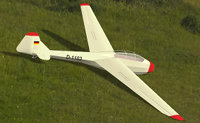
Bergfalke II/55 painted all beige like the early originals, but tips set off in
red color. Scaled 1:3.5 (186.75 in wing span) in three different weight
versions 'light', 'medium', and 'heavy'.
>download package installer
(--, 1970-01-01, 3897)
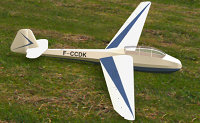
Bergfalke II/55 in a modern paint scheme like an original airplane in France,
scaled 1:4 (163.4 in wing span) in two different weight versions, 'medium'
and 'heavy'.
>download the complete Bergfalke package, see above
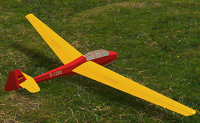
Bergfalke II/55 in colorful red and yellow paint like a museum airplane, scaled
1:5 (130.7 in wing span).
>download the complete Bergfalke package, see above
MDM-1 Fox for REFLEX XTR²
MDM-1 Fox two-seater by Marganski - Dunowski - Makula as a scale model. Since its appearance 1993 a very good aerobatic glider until 1999, it's still the standard in aerobatic instruction. For me it's just the most beautiful glider of them all. The models are good aerobats, too, but nice "slope razors" as well. Please read the document belonging to the model, either here (Fox.pdf, --) or after installation! A link to this description will be found in the menu 'Programs-REFLEX-models'. A demo flight (hit F9 in REFLEX) will show typical flight behavior.
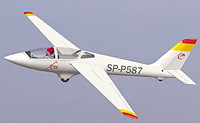
MDM-1 Fox aerobatic glider as a model scaled 1:2.4 / 1:3 / 1:3.5 / 1:4 / 1:5
with 228 in / 184 in / 158 in / 138 in / 110 in wingspan and with different
weights. This should be an original factory paint scheme.
>download package installer
(--, 1970-01-01, 3666)
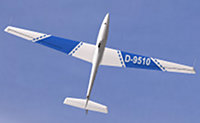
MDM-1 Fox entirely white, except an unusual pattern on the wing bottom.
>download the complete Fox package, see above
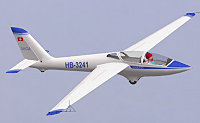
MDM-1 Fox of the SAGA with a paint scheme that is supposed to make up for
the "visual problems" of the Fox (oblique lower edge of canopy).
>download the complete Fox package, see above
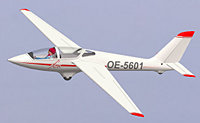
MDM-1 Fox with another paint scheme that is supposed to make up for the "visual
problems". This should be an original factory paint scheme as well.
>download the complete Fox package, see above
REFLEX XTR² Models Without Shape
Models without shape means that I didn't create a model file (mod file) for these models. Here I'm offering the flight behavior (parameters, par file), possibly also drive sounds and a simple replacement shape (dummy).
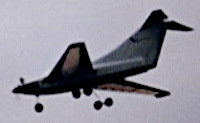
TBX-1 (1965) by Tom Brett, 1962 pattern world champion.
Different parameters with a replacement 3D model (appearance), which only
remotely resembles the real one.
In 6 steps (parameter sets), better and better setup of the model until it
really flies proper and well-behaved. Due to the T-stabilizer it has to be
flown not too slow lest you lose control!
No text file belonging to the model, please read the
thread on RCU instead!
>download installer
(--, 1970-01-01, 320)
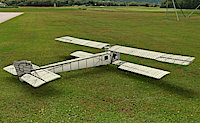
Sikorsky Ilya Muromets S-23,
four-engine WWI bomber as a model with electric drives, scaled 1:6.
With a simplified shape only, but with realistic flight characteristics.
Unusual design, possibly trimmed unstable, even if trimmed (balanced). Made for a
thread at RCU, short explanation (in English) here:
IlyaMuromets.pdf,
--
>download installer
(--, 1970-01-01, 1249)
>HD video of the demo flight on YouTube
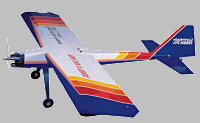
Jerry's Big Boy by Fun-Fly champion Jerry Smith, ARF by Morris Hobbies. Really
a lot of fun with a still well-mannered model. Parameters only, with a replacement
3D model (appearance), but for 5 different combustion engines and 2 different
electric motors, each with matching sound.
No text file belonging to the model, please read the
thread on RCU instead!
>download installer
(--, 1970-01-01, 2773)
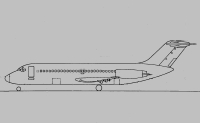
Douglas DC-9 as a model with jet and EDF engines (1:10 and 1:16 scale).
Without shape (3D model), only parameters and engine sounds, but usable with
model files by other authors. Please read the text file belonging to the model
(DC-9.txt)!
>download
(--, 1970-01-01, 1693) old parameters (1:10 and 1:16)
>download of complete package (new parameters 1:8 and 1:10) see below
REFLEX XTR² Models by Other Authors
Very nice models for which I once adjusted the flight behavior (parameters) to my liking. All following links to RC-Sim.de are obsolete now since it has been discontinued in late 2021.
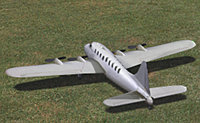
Multiplex Cargo by Martin Heimann from the year 2003 (download from
RC-Sim). Here the somewhat crude model got the correct
propellers (Günther) and the drive sound of the Multiplex Brummi.
>download installer
(--, 1970-01-01, 1349) including the Cargo model (modified) as well as my parameters.
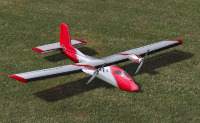
Multiplex TwinStar by Adam Walker from the year 2006 (downloaded
from RC-Sim). Here the somewhat crude model got modern propellers (APC)
and the REFLEX stock parkflyer drive sound. Even though the model has no
landing gear, it's set up for take-off from ground here because
it has the powerful drives of the latest, the ND (New Design) version.
>download installer
(--, 1970-01-01, 97) including the TwinStar model (modified) as well as my parameters.
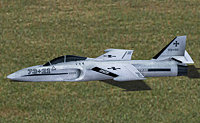
Multiplex Twister by Horst Lenkeit from the year 2008 (download from
RC-Sim). Here the very nice model got the REFLEX stock
EDF drive sound.
>download installer
(--, 1970-01-01, 1414) including the Twister model as well as my parameters.
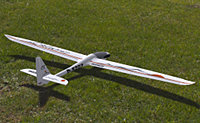
Multiplex Cularis by Horst Lenkeit from the year 2008 as pure glider
and as motor glider. Here the very nice models got REFLEX stock glider and
electric drive sounds, respectively. If you set up a "model specific
channel assignment" in REFLEX and corresponding mixers in the transmitter,
you can use all options of the four-flap-wing. Without that you'll have
flaps down (for landing) only.
>download installer
(--, 1970-01-01, 270) including the Cularis models as well as my parameters.
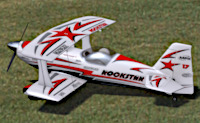
Multiplex RockStar by REFLEX from the year 2015. The control throws
of the three flight modes 'normal', 'Acro', and '3D' for my real model (and
its drive characteristics) are rendered here as additional models (parameters)
for REFLEX. The basic model is included in the REFLEX package;
>download installer
(--, 1970-01-01, 271) with my parameter sets.
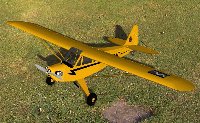
Goldberg Piper Cub and several other very well-built
models were offered by the W3 Group. All was perfectly done with much
effort and skill.
>download from
RC-Sim or, updated for the new REFLEX versions,
>download installer
(--, 1970-01-01, 886) with flight characteristics newly set up by me. By the way, it's the
clipped-wing version.

Graupner® Taxi by Bo (Jörgen) Strömberg. Very well known
beginners model from the 1960s to the 1980s. One version true to the original
and another one with ailerons and flaps.
>download from
RC-Sim or, by permission of Bo Strömberg, here:
>download installer
(--, 1970-01-01, 3744)
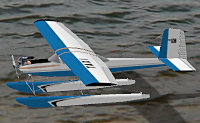
Graupner® Taxi by Bo (Jörgen) Strömberg. Both versions on
Graupner floats and with a 20% more powerful engine. Links to suitable water
sceneries are in the installer.
>download the complete Taxi installer package, see above
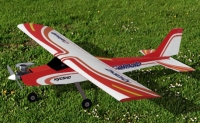
Kyosho® Calmato 40 Trainer by REFLEX. Good, simple and cheap beginner
and trainer model.
>download not available, model is included in the REFLEX package, but here's
my version of the parameters.
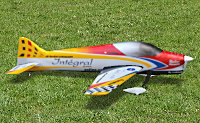
ZNLINE Intégral by Vichineu. REFLEX model of
Jean-Pierre Zardini's original F3A model. He is owner of the Belgian
manufacturer ZN LINE. Still produced F3A model with electric drive
or four-stroke engine.
>download from
RC-Sim and additionally, by permission of
Vichineu,
>download installer
(--, 1970-01-01, 2503) including his nice Zardini model as well as parameters by me.
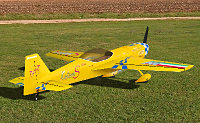
Exclusiv Modellbau Katana S
(122 in wingspan) by REFLEX. This well-known 3D model was designed by
Sebastiano Silvestri.
>download not available, model is included in the REFLEX package, but here's
my version of the parameters
along with parameters for a scale model of the original Terzi T-30 Katana.
(And you may install the Katana models made by
Klaus Eiperle.)
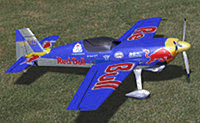
Extra EA-300S by
Gerd Gunzenhauser. REFLEX model of Peter Besenyei's original aircraft
in Red Bull outfit. Special aircraft for extreme aerobatics, as a model set
up in different scales, each both for true-to-reality flight characteristics
and for 3D.
>download from
RC-Sim or, by permission of Gerd Gunzenhauser,
here:
>download installer
(--, 1970-01-01, 4261) including his nice model (embellished) as well as parameters, a demo
flight, and some information about the model
(EA-300S.pdf,
--) by me.
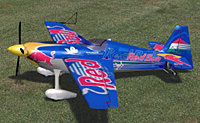 Zivko
EDGE 540 by Gerd Gunzenhauser. REFLEX model of Peter Besenyei's
original aircraft in Red Bull outfit. Special aircraft for extreme aerobatics,
as a model in 1:2.3, 1:2.7, and 1:3.5 scale with 126 in / 3.20 m, 107 in / 2.74 m,
and 84 in / 2.12 m wingspan. Each set up both for true-to-reality flight
characteristics and for 3D.
Zivko
EDGE 540 by Gerd Gunzenhauser. REFLEX model of Peter Besenyei's
original aircraft in Red Bull outfit. Special aircraft for extreme aerobatics,
as a model in 1:2.3, 1:2.7, and 1:3.5 scale with 126 in / 3.20 m, 107 in / 2.74 m,
and 84 in / 2.12 m wingspan. Each set up both for true-to-reality flight
characteristics and for 3D.
>download from
RC-Sim or, by permission of Gerd Gunzenhauser, here:
>download installer
(--, 1970-01-01, 3583) including his nice model (embellished) as well as parameters, a demo
flight, and some information about the model
(EDGE 540.pdf,
--) by me.
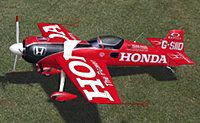 Sukhoi Su-26M by Gerd Gunzenhauser. REFLEX
model of Will Curtis' original aircraft in Honda outfit. Special aircraft
for extreme aerobatics, as a model set up in different scales, each both
for true-to-reality flight characteristics and for 3D.
Sukhoi Su-26M by Gerd Gunzenhauser. REFLEX
model of Will Curtis' original aircraft in Honda outfit. Special aircraft
for extreme aerobatics, as a model set up in different scales, each both
for true-to-reality flight characteristics and for 3D.
>download from
RC-Sim or, by permission of Gerd Gunzenhauser, here:
>download installer
(--, 1970-01-01, 3715) including his nice model (embellished) as well as parameters, a demo
flight, and some information about the model
(Su-26M.pdf,
--) by me.
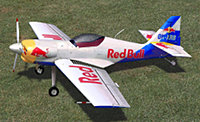 Zlin Z-50LS by
Gerd Gunzenhauser. REFLEX model after an original aircraft of the
Czech team The Flying
Bulls. Special aircraft for classic aerobatics, as a model set up in
different scales and as much as possible for true-to-reality flight
characteristics, but not for 3D.
Zlin Z-50LS by
Gerd Gunzenhauser. REFLEX model after an original aircraft of the
Czech team The Flying
Bulls. Special aircraft for classic aerobatics, as a model set up in
different scales and as much as possible for true-to-reality flight
characteristics, but not for 3D.
>download from
RC-Sim or, by permission of Gerd Gunzenhauser, here:
>download installer
(--, 1970-01-01, 3096) including his nice model (embellished) as well as parameters, a demo
flight, and some information about the model
(Z-50LS.pdf,
--) by me.
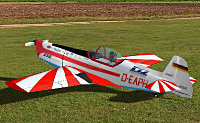 Zlin Z-526AFS by
Janning Quint. REFLEX model after a real scale model with flaps and
retractable landing gear, with the creator in the cockpit.
Special aircraft for classic aerobatics, as a model set up in different scales
and as true-to-reality as possible in flight characteristics, but not for 3D.
Zlin Z-526AFS by
Janning Quint. REFLEX model after a real scale model with flaps and
retractable landing gear, with the creator in the cockpit.
Special aircraft for classic aerobatics, as a model set up in different scales
and as true-to-reality as possible in flight characteristics, but not for 3D.
>download from
RC-Sim or, by permission of Janning Quint, here:
>download installer
(--, 1970-01-01, 4036) including his nice model, slightly modified, as well as parameters, two demo
flights, and some information about the model
(Z-526AFS.pdf,
--) by me.
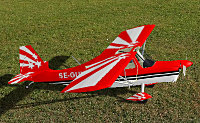
Bellanca
Super Decathlon by Ingo Fischer ('gnorf' in the RC-Sim forum). Popular
aerobatic trainer and as model also used as tug. REFLEX model after the
original aircraft in red Starburst paint scheme.
>download from Ingo's website, and here's
my version of the parameters
for scale models of the original's geometry, after models by
Exclusiv-Modellbau,
Fliegerland, and
Hacker Model.
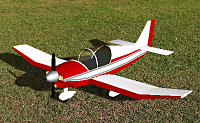 Robin DR 400
by Urs Stocker from the RC-Sim forum. Both the original and the models
are popular tow planes.
Robin DR 400
by Urs Stocker from the RC-Sim forum. Both the original and the models
are popular tow planes.
>download from
RC-Sim, and here's
my version of the parameters
for scale models of the original's geometry,
first with 86 in wingspan (1:4) after a model by Rödelmodell,
second with 102 in wingspan (1:3.4) after a model by EuroLight,
third with 114 in wingspan (1:3) after a model by
Airworld, all with a strong drive for glider towing.
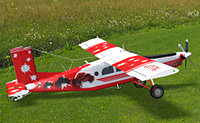
Pilatus
PC-6 Turbo Porter by Ingo Fischer ('gnorf' in the RC-Sim forum) and
parameters by Torsten Wolf ('Ghostraider' in the RC-Sim forum).
Well-known STOL utility airplane. REFLEX model of an original aircraft.
>download from
RC-Sim, and here's
my version of the parameters
for a giant 1:3.5 scale model of the original's geometry, featuring a model
turboprop engine.
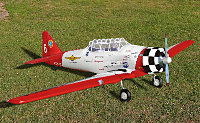
North American
AT-6 Texan by Janning Quint. REFLEX model after a real 1:5
scale model with flaps and retractable landing gear, probably after a
Nick Ziroli plan. The original belongs to the
AeroShell Aerobatic Team.
>download from
RC-Sim, and here are
my parameter versions
for 1:5 and 1:3.5 scale models of the original's geometry.
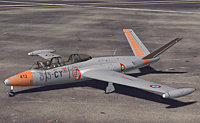 Fouga CM.170 Magister by Jürgen Dreyer (DL3FY).
REFLEX model of an aircraft of the French air force. My versions with jet and
EDF power are scaled 1:3.5, 1:4, 1:5, and 1:7.5. No description, please try
yourself!
Fouga CM.170 Magister by Jürgen Dreyer (DL3FY).
REFLEX model of an aircraft of the French air force. My versions with jet and
EDF power are scaled 1:3.5, 1:4, 1:5, and 1:7.5. No description, please try
yourself!
>download from
RC-Sim or, by permission of Jürgen Dreyer:
>download installer
(--, 1970-01-01, 1687) including his model (modified) as well as my parameters and demo flight.
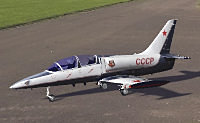 AERO L-39 by Gerd
Gunzenhauser. REFLEX model of Allen Smith's original aircraft N9YC
and my parameters for scale models of the original's geometry: first
75" wingspan (1:5) for a jet-powered model by
Airworld,
second 54" wingspan (1:7) for a jet- or EDF-powered model by Airworld,
and last 50" wingspan (1:7.5) for an EDF model by Schreiner. The four
versions are excellent for a step-up jet training!
AERO L-39 by Gerd
Gunzenhauser. REFLEX model of Allen Smith's original aircraft N9YC
and my parameters for scale models of the original's geometry: first
75" wingspan (1:5) for a jet-powered model by
Airworld,
second 54" wingspan (1:7) for a jet- or EDF-powered model by Airworld,
and last 50" wingspan (1:7.5) for an EDF model by Schreiner. The four
versions are excellent for a step-up jet training!
>download from
RC-Sim or, by permission of Gerd Gunzenhauser, here:
>download installer
(--, 1970-01-01, 3456) including his nice model (embellished) as well as parameters, two demo
flights, and some information about the model
(L-39.pdf,
--) by me.
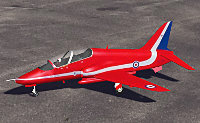 BAe Hawk T.1 by Eric Fague. REFLEX models of an
aircraft of the Red Arrows (download from
RC-Sim) and of an aircraft of the Swiss Air Force
(download from
RC-Sim). My versions of the parameters are made for
scale models of the original's geometry, one with 82 in wingspan (1:4.5)
after a jet-powered model by
Airworld, and one
with 48 in wingspan (1:8) after an EDF model by
Schübeler.
By permission of Eric Fague:
BAe Hawk T.1 by Eric Fague. REFLEX models of an
aircraft of the Red Arrows (download from
RC-Sim) and of an aircraft of the Swiss Air Force
(download from
RC-Sim). My versions of the parameters are made for
scale models of the original's geometry, one with 82 in wingspan (1:4.5)
after a jet-powered model by
Airworld, and one
with 48 in wingspan (1:8) after an EDF model by
Schübeler.
By permission of Eric Fague:
>download installer
(--, 1970-01-01, 2037) including his models (modified) as well as my parameters. (Flaps don't move
but their effect should be there.)
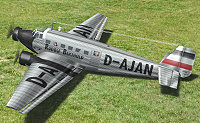 Junkers Ju 52/3m by Jürgen Dreyer (DL3FY)
from the year 2006 (download from
RC-Sim). Good old "Auntie Ju" as a model scaled 1:4.73
(real, heavy model), 1:6.5, and 1:8 (fictitious, lightweight
models). For comparison with the DC-3, DC-6, Transall C-160, and C-130 Hercules.
The position lights will shine in darkness, for instance in the Fischen Moonlight scenery.
By permission of Jürgen Dreyer:
Junkers Ju 52/3m by Jürgen Dreyer (DL3FY)
from the year 2006 (download from
RC-Sim). Good old "Auntie Ju" as a model scaled 1:4.73
(real, heavy model), 1:6.5, and 1:8 (fictitious, lightweight
models). For comparison with the DC-3, DC-6, Transall C-160, and C-130 Hercules.
The position lights will shine in darkness, for instance in the Fischen Moonlight scenery.
By permission of Jürgen Dreyer:
>download installer
(--, 1970-01-01, 2300) including his model (modified) as well as my parameters and demo flight.
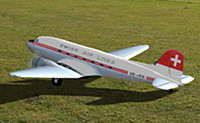 Douglas
DC-3 by Vichineu. Probably the best-known airplane in the world.
Originally a REFLEX model of a FiberClassics model scaled 1:9, but now
also scaled 1:12, 1:8 (Nick Ziroli), and 1:6.5 (fictitious). With electric
drives or four-stroke glow engines and different weights for comparison.
Douglas
DC-3 by Vichineu. Probably the best-known airplane in the world.
Originally a REFLEX model of a FiberClassics model scaled 1:9, but now
also scaled 1:12, 1:8 (Nick Ziroli), and 1:6.5 (fictitious). With electric
drives or four-stroke glow engines and different weights for comparison.
>download from RC-Sim or, by permission of Vichineu,
>download installer
(--, 1970-01-01, 1039) including his DC-3 model (modified) as well as my parameters, demo flight,
and description
(DC-3.pdf,
--).
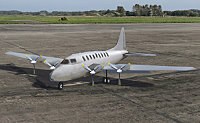 Douglas DC-6 guised as the Multiplex Cargo by
Martin Heimann from the year 2003 (download from
RC-Sim). Here it provides a dummy, but even got the correct
propellers, landing gear, and simple flaps. Thereby it behaves (and sounds)
true-to-original, scaled 1:6.5 and 1:8. For comparison with the DC-3 and the
Hercules.
Douglas DC-6 guised as the Multiplex Cargo by
Martin Heimann from the year 2003 (download from
RC-Sim). Here it provides a dummy, but even got the correct
propellers, landing gear, and simple flaps. Thereby it behaves (and sounds)
true-to-original, scaled 1:6.5 and 1:8. For comparison with the DC-3 and the
Hercules.
>download installer
(--, 1970-01-01, 2357) including the Cargo
model (modified) as well as my parameters and demo flight.
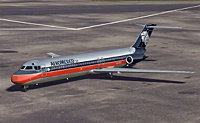 Douglas DC-9-15 guised as the DC-9-40 model by
Jürgen Dreyer (DL3FY) from the year 2005 (download from
RC-Sim). The -15 was the first, smallest version -10 but
with more powerful engines. It lends itself to be rendered in REFLEX because it
has no leading edge slats. The -40 is longer but otherwise similar. The models
behave true-to-original, scaled 1:8 and 1:10. No description, please try
yourself! By permission of Jürgen Dreyer:
Douglas DC-9-15 guised as the DC-9-40 model by
Jürgen Dreyer (DL3FY) from the year 2005 (download from
RC-Sim). The -15 was the first, smallest version -10 but
with more powerful engines. It lends itself to be rendered in REFLEX because it
has no leading edge slats. The -40 is longer but otherwise similar. The models
behave true-to-original, scaled 1:8 and 1:10. No description, please try
yourself! By permission of Jürgen Dreyer:
>download installer
(--, 1970-01-01, 2026) including his model (modified) as well as my parameters and demo flight.
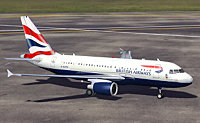 Airbus
A318 by Jürgen Dreyer (DL3FY) from the year 2005 (download from
RC-Sim). The "Baby Bus" as a model scaled 1:10
and 1:16 with jet and EDF engines. Please read the text file belonging to the
model (A318.txt)! By permission of Jürgen Dreyer:
Airbus
A318 by Jürgen Dreyer (DL3FY) from the year 2005 (download from
RC-Sim). The "Baby Bus" as a model scaled 1:10
and 1:16 with jet and EDF engines. Please read the text file belonging to the
model (A318.txt)! By permission of Jürgen Dreyer:
>download installer
(--, 1970-01-01, 2772) including his model (modified) as well as my parameters, demo flight,
and description
(A318.txt,
--).
>HD video of the demo flight on YouTube
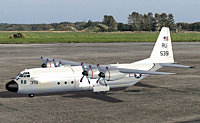 Lockheed C-130 Hercules by Jürgen Dreyer (DL3FY).
REFLEX model of a real model scaled 1:6.5 with 20 ft wingspan and 140 lbs
weight, powered by four ZG38 gas engines. As well scaled 1:8 and 1:10.
Lockheed C-130 Hercules by Jürgen Dreyer (DL3FY).
REFLEX model of a real model scaled 1:6.5 with 20 ft wingspan and 140 lbs
weight, powered by four ZG38 gas engines. As well scaled 1:8 and 1:10.
>download from RC-Sim or, by permission of Jürgen Dreyer:
>download installer
(--, 1970-01-01, 3074) with his modified model, my parameters, demo flight, and description
(Hercules.pdf,
--).
(Many suitable sceneries are characterized in the description; they can be downloaded
and installed in the Hercules installer.)
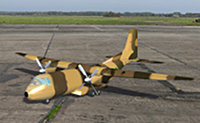 Transall C-160 guised as the model by Lothar Neubeck
from the year 2003 (download from
RC-Sim). It's rather simple and looks remotely like a
Transall, but even got the correct propellers and a better landing gear.
Thereby it behaves (and sounds) true-to-original, scaled 1:6.5 and 1:8. For
comparison with the Hercules, both empty and loaded.
Transall C-160 guised as the model by Lothar Neubeck
from the year 2003 (download from
RC-Sim). It's rather simple and looks remotely like a
Transall, but even got the correct propellers and a better landing gear.
Thereby it behaves (and sounds) true-to-original, scaled 1:6.5 and 1:8. For
comparison with the Hercules, both empty and loaded.
>download installer
(--, 1970-01-01, 2231) including the simple model (modified) as well as my parameters and demo flight.
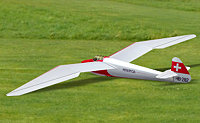
Göppingen Gö 3 Minimoa von REFLEX. The first
high-performance sailplane built in larger quantities, a classic designed 1935.
In addition to the REFLEX stock model, several parameter sets for different
model scales and weights.
>download not available, model is included in the REFLEX package,
but here's a
>download installer
(--, 1970-01-01, 2669) including my parameters, comments on flight behavior
(Minimoa.pdf,
--), and demo flight.
Scale Models Scaled 1:3.5 for REFLEX XTR²
Several models offered above are "Scale" models scaled 1:3.5 and got flight characteristics as realistic (true to original) as possible. It's just interesting to compare them, may it be the well-known aerobats or even sport aircraft, gliders, and jets. The point of this installer programm: it installs the best variant each of the selected REFLEX models additionally in an own folder just for convenience.
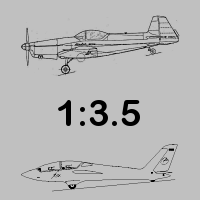 Included models:
Included models:
| Extra EA-300S | Bölkow Bo 208 A Junior | Scheibe Bergfalke II-55 |
| Zivko EDGE 540 | Robin DR 400 - 180R | Göppingen Gö 3 Minimoa |
| Sukhoi Su-26M | Pilatus PC-6 Turbo Porter | MDM-1 Fox |
| Zlin Z-50 LS | North American AT-6 | |
| Zlin Z-526 AFS | Fouga CM.170 Magister | |
| Bellanca 8KCAB Super Decathlon |
(--, 1970-01-01, 1843)
Heli Models for REFLEX XTR²
Eric Fague ("Ericoptère") from Switzerland built some nice helicopter models for REFLEX and published them on www.RC-Sim.de several years ago. Actually, they are nice even today and still worth to be flown in the simulator. For the REFLEX version 5.05, and later 5.09, they have been brushed up (and equipped with a heading-lock gyro) and are now – by permission of Eric – re-published here.
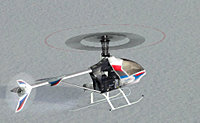 HIROBO Shuttle Plus 30. The HIROBO advertizing claims that more
than half of all model heli pilots worldwide have learned to fly with a
Shuttle. That may be even true, particularly since the model is still being
sold since 1985. Eric's realistic REFLEX model is of 2003. It is
really set up for beginners with its 1400 main rotor rpm. The blade pitch is
limited to -8° and +8°, but at least you may flip the heli on its back.
HIROBO Shuttle Plus 30. The HIROBO advertizing claims that more
than half of all model heli pilots worldwide have learned to fly with a
Shuttle. That may be even true, particularly since the model is still being
sold since 1985. Eric's realistic REFLEX model is of 2003. It is
really set up for beginners with its 1400 main rotor rpm. The blade pitch is
limited to -8° and +8°, but at least you may flip the heli on its back.
>download package installer
(--, 1970-01-01, 2255)
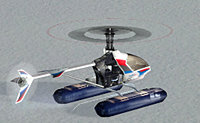 HIROBO Shuttle Plus 30 on floats. Wide undercarriages with inflatable floats
made from plastic film have been used quite often by rank beginners. With them,
the heli can slide around on the ground without toppling over. Today, rather
two crossed sticks with table tennis balls at their tips are simply strapped
to the skids. Rotor rpm and blade pitch are the same as on the skids version.
HIROBO Shuttle Plus 30 on floats. Wide undercarriages with inflatable floats
made from plastic film have been used quite often by rank beginners. With them,
the heli can slide around on the ground without toppling over. Today, rather
two crossed sticks with table tennis balls at their tips are simply strapped
to the skids. Rotor rpm and blade pitch are the same as on the skids version.
>download the complete Shuttle package, see above
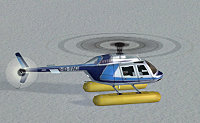 KYOSHO Concept 30 SE on floats. This was the equivalent beginners heli
by KYOSHO. Eric's cute and realistic model is of 2003 as well. It has a
semi-scale body (fuselage) as an addition (Bell 206 Jet Ranger). This is
intended to be not only pretty but above all more visible. After all, for
beginners the perceptability of the heli's attitude is especially important.
That's also why the rotor blades have stripes that look like circles when
the rotor is rotating.
KYOSHO Concept 30 SE on floats. This was the equivalent beginners heli
by KYOSHO. Eric's cute and realistic model is of 2003 as well. It has a
semi-scale body (fuselage) as an addition (Bell 206 Jet Ranger). This is
intended to be not only pretty but above all more visible. After all, for
beginners the perceptability of the heli's attitude is especially important.
That's also why the rotor blades have stripes that look like circles when
the rotor is rotating.
>download package installer
(--, 1970-01-01, 1917)
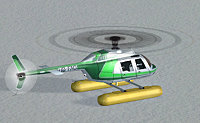 KYOSHO Concept 30 SE on floats. This version for rank beginners is appropriately
set up with only 1400 rotor rpm. The blade pitch is asymmetrically limited to
-2° and +10°, so not suited for inverted flight. The heli moves quite
sluggishly and docile with this setup. By the way, I prefer this green version
on floats. And by the way, it's good also on snow and ice and of course it even
"floats" (for instance in the "Baggersee" water scenery).
KYOSHO Concept 30 SE on floats. This version for rank beginners is appropriately
set up with only 1400 rotor rpm. The blade pitch is asymmetrically limited to
-2° and +10°, so not suited for inverted flight. The heli moves quite
sluggishly and docile with this setup. By the way, I prefer this green version
on floats. And by the way, it's good also on snow and ice and of course it even
"floats" (for instance in the "Baggersee" water scenery).
>download the complete Concept package, see above
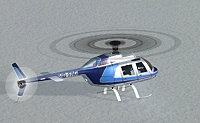 KYOSHO Concept 30 SE on skids. For this version I like the blue painting better,
for whatever reason. Anyway, this version with 1500 U/min rotor rpm and blade
pitch between -2° and +12° is noticeably more agile and more fun, and
so it is more instructive as well.
KYOSHO Concept 30 SE on skids. For this version I like the blue painting better,
for whatever reason. Anyway, this version with 1500 U/min rotor rpm and blade
pitch between -2° and +12° is noticeably more agile and more fun, and
so it is more instructive as well.
>download the complete Concept package, see above
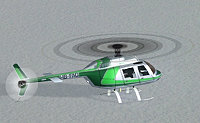 KYOSHO Concept 30 SE on skids. A beginner should switch to the "proper"
version on skids right after the first successful sliding attempts on the ground.
The floats version is merely intended to avoid frustration (and in reality damage,
above all) in the very beginning.
KYOSHO Concept 30 SE on skids. A beginner should switch to the "proper"
version on skids right after the first successful sliding attempts on the ground.
The floats version is merely intended to avoid frustration (and in reality damage,
above all) in the very beginning.
>download the complete Concept package, see above
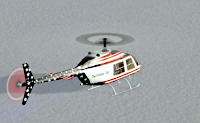 Graupner Star Ranger in the livery of
Santini Air.
Eric Fague built this detailed model in 2004.
It's quite big (1.41 m rotor diameter) and heavy (4.5 kg weight).
It has Graupner/heim UNI-Mechanics and is here set up
as a quite agile trainer.
Due to the big body with its striking paint scheme also this model
can be a good beginners heli.
Graupner Star Ranger in the livery of
Santini Air.
Eric Fague built this detailed model in 2004.
It's quite big (1.41 m rotor diameter) and heavy (4.5 kg weight).
It has Graupner/heim UNI-Mechanics and is here set up
as a quite agile trainer.
Due to the big body with its striking paint scheme also this model
can be a good beginners heli.
>download package installer
(--, 1970-01-01, 342)
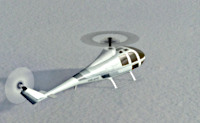 Graupner Lockheed 286h. The same as the Star Ranger:
built in 2004, 1.41 m rotor diameter, 4.5 kg weight,
Graupner/heim UNI-Mechanics and set up
as a quite agile trainer.
This model has a not as tall body with a low landing gear
and an unobtrusive paint scheme.
Graupner Lockheed 286h. The same as the Star Ranger:
built in 2004, 1.41 m rotor diameter, 4.5 kg weight,
Graupner/heim UNI-Mechanics and set up
as a quite agile trainer.
This model has a not as tall body with a low landing gear
and an unobtrusive paint scheme.
>download package installer
(--, 1970-01-01, 289)
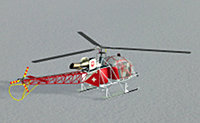 Aérospatiale SA 315B Lama of Heliswiss.
Eric Fague's REFLEX models are from 2003. The Lama is an alpine helicopter
and therefore used especially in Switzerland. This model version is quite big
and electrically powered.
Aérospatiale SA 315B Lama of Heliswiss.
Eric Fague's REFLEX models are from 2003. The Lama is an alpine helicopter
and therefore used especially in Switzerland. This model version is quite big
and electrically powered.
>download package installer
(--, 1970-01-01, 2565)
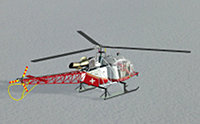 Aérospatiale SA 315B Lama of Air-Glaciers. This version is just as big
and heavy and actually the same, except the color scheme of course and a
combustion engine. By the way, Eric used xmodder to convert FMS models by
"Logic Wizard" into these Reflex models.
Aérospatiale SA 315B Lama of Air-Glaciers. This version is just as big
and heavy and actually the same, except the color scheme of course and a
combustion engine. By the way, Eric used xmodder to convert FMS models by
"Logic Wizard" into these Reflex models.
>download the complete Lama package, see above
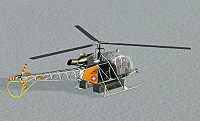 Aérospatiale SA 315B Lama, made by Eric for
G2loq.
It's smaller, the model has no company markings, it has equipment
containers under the fuselage, and it's electrically powered. Otherwise
it's the same as the other two Lamas.
Aérospatiale SA 315B Lama, made by Eric for
G2loq.
It's smaller, the model has no company markings, it has equipment
containers under the fuselage, and it's electrically powered. Otherwise
it's the same as the other two Lamas.
>download the complete Lama package, see above
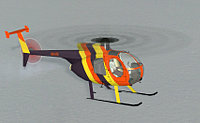 Hughes 500D like in the
TV series Magnum P.I.
Eric Fague's REFLEX model is from 2003. The pilot in the TV series,
T.C., is sitting in the fully equipped cockpit. The
right door can be opened with the landing gear switch. The model is quite
big and well-mannered. The big body with eye-catching paint scheme and the
cross-striped main rotor blades make for good visibility. I always conceived
it as a good beginners heli and it is set up as one. By the way, it looks
great in REFLEX's night flying as well as in Ronald Bankert's
Fischen night flying scenery.
Hughes 500D like in the
TV series Magnum P.I.
Eric Fague's REFLEX model is from 2003. The pilot in the TV series,
T.C., is sitting in the fully equipped cockpit. The
right door can be opened with the landing gear switch. The model is quite
big and well-mannered. The big body with eye-catching paint scheme and the
cross-striped main rotor blades make for good visibility. I always conceived
it as a good beginners heli and it is set up as one. By the way, it looks
great in REFLEX's night flying as well as in Ronald Bankert's
Fischen night flying scenery.
>download package installer
(--, 1970-01-01, 2352)
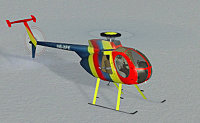 Hughes 500D in a typical colorful livery and on high skids. This model
(2004) is a bit smaller, more powerful, and doesn't have striped main rotor
blades, but it's yet a good beginners model as well. It has interior equipment
and pilot but the doors can't be opened. Eric had placed the pilot in the right
seat, as usual, but in the Hughes 500 it's different. Now he's sitting in
the left seat, like the real T.C. in the TV series.
Hughes 500D in a typical colorful livery and on high skids. This model
(2004) is a bit smaller, more powerful, and doesn't have striped main rotor
blades, but it's yet a good beginners model as well. It has interior equipment
and pilot but the doors can't be opened. Eric had placed the pilot in the right
seat, as usual, but in the Hughes 500 it's different. Now he's sitting in
the left seat, like the real T.C. in the TV series.
>download the complete Hughes 500 package, see above
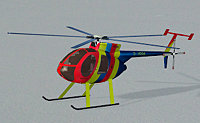 Hughes 500E as replica of the PEKA Hughes by
Günter Knipprath. This was one of the first model helicopters with
JetCat turbine drive, big with 2 meters main rotor diameter. The REFLEX
model from 2005 shows the innards of the original model with the turbine.
Typical PEKA paint scheme, German registration. All these
models have the high skids.
Hughes 500E as replica of the PEKA Hughes by
Günter Knipprath. This was one of the first model helicopters with
JetCat turbine drive, big with 2 meters main rotor diameter. The REFLEX
model from 2005 shows the innards of the original model with the turbine.
Typical PEKA paint scheme, German registration. All these
models have the high skids.
>download the complete Hughes 500 package, see above
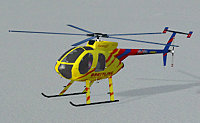 Hughes 500E analog to the PEKA Hughes. An original's
Breitling paint scheme and Swiss registration.
The flight characteristics were not adapted to the recent
REFLEX versions and thus partially unusual, but not too bad.
I virtually set a flybarless system in the parameters,
now the models fly very good.
Hughes 500E analog to the PEKA Hughes. An original's
Breitling paint scheme and Swiss registration.
The flight characteristics were not adapted to the recent
REFLEX versions and thus partially unusual, but not too bad.
I virtually set a flybarless system in the parameters,
now the models fly very good.
>download the complete Hughes 500 package, see above
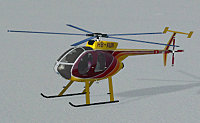 Hughes 500E analog to the PEKA Hughes. Yet another
original's paint scheme and Swiss registration.
Besides I rendered the real rotor blade count for even more realistic
flight characteristics. Hence the Breitling version's 2-blade tail rotor
is marginal and needs more rpm. This version's 4-blader is all right
with less rpm.
Hughes 500E analog to the PEKA Hughes. Yet another
original's paint scheme and Swiss registration.
Besides I rendered the real rotor blade count for even more realistic
flight characteristics. Hence the Breitling version's 2-blade tail rotor
is marginal and needs more rpm. This version's 4-blader is all right
with less rpm.
>download the complete Hughes 500 package, see above
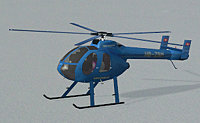 MD 520N analog to the PEKA Hughes. Simply in blue with
Swiss registration. The NOTAR system as a tail rotor replacement can not be
rendered in REFLEX and is in turn replaced by equivalent tail rotor parameters
as realistic as possible. I set some expo on all four PEKA versions.
MD 520N analog to the PEKA Hughes. Simply in blue with
Swiss registration. The NOTAR system as a tail rotor replacement can not be
rendered in REFLEX and is in turn replaced by equivalent tail rotor parameters
as realistic as possible. I set some expo on all four PEKA versions.
>download the complete Hughes 500 package, see above
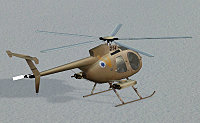 Hughes 500MD Defender military version. This REFLEX model
from 2006 is normally sized and flies quite well. By the way, Eric writes
that he built these models with RMK especially for REFLEX.
Hughes 500MD Defender military version. This REFLEX model
from 2006 is normally sized and flies quite well. By the way, Eric writes
that he built these models with RMK especially for REFLEX.
>download the complete Hughes 500 package, see above
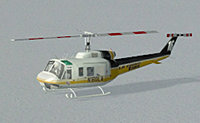 Bell 205 of the
Los Angeles County Fire Department.
In 2004, Eric Fague converted this detailed model from a FMS model by
"Logic Wizard" into a REFLEX model using xmodder.
It's quite big (1.85 m rotor diameter) and heavy (8.5 kg weight).
The big body with its paint scheme and the cross-striped rotor blades
make for good visibility. That's why also this model could be a good
beginners heli.
Bell 205 of the
Los Angeles County Fire Department.
In 2004, Eric Fague converted this detailed model from a FMS model by
"Logic Wizard" into a REFLEX model using xmodder.
It's quite big (1.85 m rotor diameter) and heavy (8.5 kg weight).
The big body with its paint scheme and the cross-striped rotor blades
make for good visibility. That's why also this model could be a good
beginners heli.
>download package installer
(--, 1970-01-01, 2538)
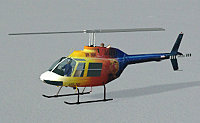 Bell 206 of
Ayers Rock Helicopters.
In 2005, Eric Fague converted the three 206 models from FMS models by
"Logic Wizard" into REFLEX models using xmodder.
This one has 2.50 m rotor diameter, weighs 17 kg, and is powered by a
gas engine. Back then Eric wrote it corresponds to the
Jet Ranger III XL by Vario (with gas engine,
today with electric motor or turbine).
Bell 206 of
Ayers Rock Helicopters.
In 2005, Eric Fague converted the three 206 models from FMS models by
"Logic Wizard" into REFLEX models using xmodder.
This one has 2.50 m rotor diameter, weighs 17 kg, and is powered by a
gas engine. Back then Eric wrote it corresponds to the
Jet Ranger III XL by Vario (with gas engine,
today with electric motor or turbine).
>download the complete Bell 205/206 package, see above
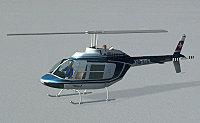 Bell 206 with Swiss registration.
These 206 models are relatively coarse and have a somewhat fuzzy paint scheme,
but they are nice and quite good fliers.
This one has even 3.00 m rotor diameter but weighs only 15 kg,
as well powered by a gas engine.
Bell 206 with Swiss registration.
These 206 models are relatively coarse and have a somewhat fuzzy paint scheme,
but they are nice and quite good fliers.
This one has even 3.00 m rotor diameter but weighs only 15 kg,
as well powered by a gas engine.
>download the complete Bell 205/206 package, see above
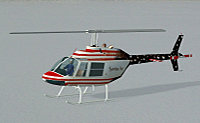 Bell 206 of
Santini Air.
This model has 3.00 m rotor diameter, weighs 15 kg
and is powered by a gas engine as well.
Back then Eric asked that someone make better parameters for the
flight behavior. This request is still not granted, but actually
Eric has always made good parameters. And he added a short demo
flight (hit F9 in REFLEX, Bell 206 Santini Air).
Bell 206 of
Santini Air.
This model has 3.00 m rotor diameter, weighs 15 kg
and is powered by a gas engine as well.
Back then Eric asked that someone make better parameters for the
flight behavior. This request is still not granted, but actually
Eric has always made good parameters. And he added a short demo
flight (hit F9 in REFLEX, Bell 206 Santini Air).
>download the complete Bell 205/206 package, see above
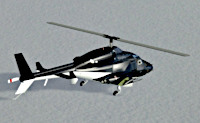 Airwolf from the same-titled
TV series.
Eric Fague built this model in 2006 and published it in 2007.
It has normal size (1.55 m rotor) and weight (5.2 kg)
and I turned it into an electric helicopter.
Eric set up also a quite big version (3 m rotor, 20 kg weight)
with turbine and interesting flight characteristics. Except
heading-lock gyro and expo for the tail rotor, I didn't change
anything.
Airwolf from the same-titled
TV series.
Eric Fague built this model in 2006 and published it in 2007.
It has normal size (1.55 m rotor) and weight (5.2 kg)
and I turned it into an electric helicopter.
Eric set up also a quite big version (3 m rotor, 20 kg weight)
with turbine and interesting flight characteristics. Except
heading-lock gyro and expo for the tail rotor, I didn't change
anything.
>download package installer
(--, 1970-01-01, 426)
Jürgen Dreyer (DL3FY) built quite a number of airplane models for REFLEX. That was several years ago and he built a few helicopter models as well (all his models published on www.RC-Sim.de). At least one of them is nice even today and still worth to be flown in the simulator. For the REFLEX version 5.09 it has been brushed up and is now – by permission of Jürgen – re-published here.
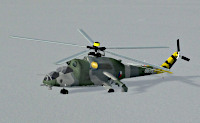 Mil Mi-24C Hind.
Jürgen Dreyer probably converted this detailed model from a FMS model
by "Logic Wizard" into a REFLEX model. Here it's set up like the
modern model by
HeliClassics:
rotor diameter 2.5m, weight 25kg, turbine 12 kW.
No idea if that is realistic but in the simulator it flies nicely and
like the real model in a
video.
Mil Mi-24C Hind.
Jürgen Dreyer probably converted this detailed model from a FMS model
by "Logic Wizard" into a REFLEX model. Here it's set up like the
modern model by
HeliClassics:
rotor diameter 2.5m, weight 25kg, turbine 12 kW.
No idea if that is realistic but in the simulator it flies nicely and
like the real model in a
video.
Something special:
The rotor mast is now tilted forward and to the left side –
like on the original. Hence the fuselage is level and upright in flight
(not tilted) and the helicopter takes off straight forward.
>download package installer
(--, 1970-01-01, 370)
REFLEX XTR² Model Components
Objects for building models in RMK, and drive sounds. Most of them I created myself but some are made by other authors.
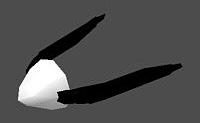
Objects for the REFLEX model construction program RMK: airfoils, propellers,
propeller blades, spinners, engines, motors, whole drives.
>download
(--, 1970-01-01, 1882)
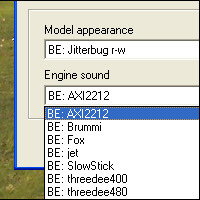
The 'engine sounds' of my REFLEX models are more characteristic for the model's
drive than for the model-drive combination. The sounds should therefore fit any
other model with the same drive. If you only want the sounds, here are all
sound files combined in a ZIP file. It includes short descriptions of the
sounds and recording instructions (ReflexSoundsBE.txt).
>download
(--, 1970-01-01, 2652)
Model and Scenery Management for REFLEX XTR²
On this web page, more than 60 additional models for REFLEX are offered, nearly all in an installer program that can be run via an entry in the Windows menu "Start - All Apps". That gets confusing (and Windows 10 and 11 are no help) so the model manager offered here can be a help. It neatly categorizes the models, downloads them, and installs them after you just ticked their entry, and it even removes them if you un-tick them. It manages already installed models by running the respective installer again (if you simply tick another checkbox) so you can install other variants of a model. The categories and the order are the same as on this web page:
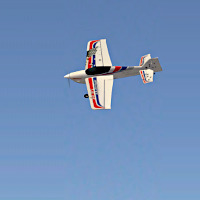
| Airplane Models |
| Parkflyers and Electric Gliders (9) |
| Classic Model Airplanes (6) |
| Scale Model Airplanes (3) |
| Models without proper shape (3) |
| Models by Other Authors (31) |
| Helicopter Models (9) |
(--, 1970-01-01, 198)
(This is not one of the managed models.
It's the Multiplex AcroMaster by Horst Lenkeit,
which went ahead of the REFLEX version.)
Additional to the sceneries included in REFLEX, there is a bunch of nice sceneries made by independent authors. They offer their respective sceneries at their own websites so you have to find, download, and install them. These tasks are taken care of by the scenery manager offered here. It neatly categorizes more than 40 sceneries, downloads them, and installs them after you just ticked their entry, and it even removes them if you un-tick them. It manages already installed sceneries all the same. The categories:
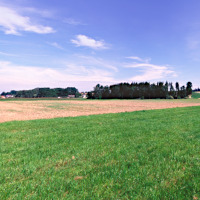
| model flying fields | slope soaring | authors with website: |
| grass runway (7) | uplands (7) | Paul Dürr |
| paved runway (3) | alpine (3) | Harald Bendschneider |
| heli fields (3) | water and land (5) | Ronald Bankert |
| places to fly | snow and ice (4) | |
| plain (5) | sports halls (2) | |
| unusual (3) |
(--, 1970-01-01, 129)
(This is not one of the managed sceneries.
It's
the place where I once flew my models.
The respective scenery has never been finished.)
Stability Calculations with Plane Geometry
The geometries of my models were measured and entered into the spreadsheets Plane Geometry by Blaine K. Beron-Rawdon. The moments of inertia of the models were measured too and used in the calculation of stability data as far as 'Plane Geometry' can do this. Models not available to me were measured from drawings published in the WWW, moments of inertia were estimated. The spreadsheets 'MeasureC/V' and 'DesignC/V' from 'Plane Geometry' with the model data are available here. With respect to the copyright, all formulas are deleted and there is no documentation of 'Plane Geometry'.
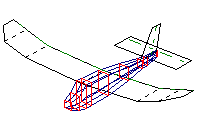
Brummi parkflyer by Multiplex®.
(Measured moments of inertia.)
>download
(--, 1970-01-01, 2090)
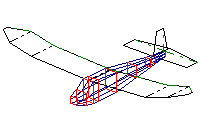
Miss 2 parkflyer by Scorpio®.
>download
(--, 1970-01-01, 1121)
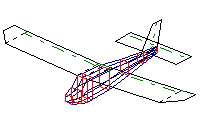
Super Miss parkflyer by Ripmax/Scorpio® or Hobby Lobby®.
>download
(--, 1970-01-01, 1176)
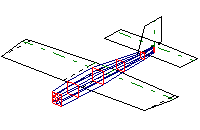
threedee400 aerobatic parkflyer by Ripmax/Scorpio® or Hobby
Lobby®.
(Measured moments of inertia.)
>download
(--, 1970-01-01, 1241)
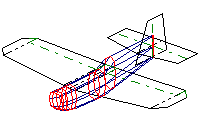
Jitterbug aerobatic biplane by Dave Szuter, in Plane Geometry only as
equivalent monoplane.
>download
(--, 1970-01-01, 1129)
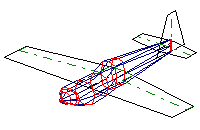
Mini Edge 540 3D by E-flite.
>download
(--, 1970-01-01, 808)
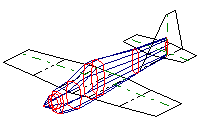
AcroMaster by Multiplex®.
>download
(--, 1970-01-01, 812)
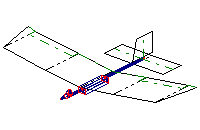
Slow Stick slowflyer by GWS®.
>download
(--, 1970-01-01, 1316)
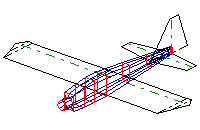
Jerry's Big Boy by Morris Hobbies.
>download
(--, 1970-01-01, 768)
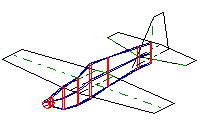
Blade 3D EPP by Freeair.
>download
(--, 1970-01-01, 1278)
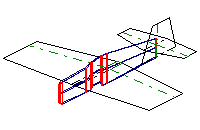
Attitude 3D by Todd Long.
>download
(--, 1970-01-01, 993)
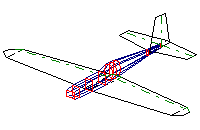
Race-E aerobatic sports model by Harry Stewart.
>download
(--, 1970-01-01, 1095)
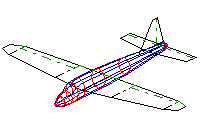
Cargo EPP 4-motor electric by Multiplex®.
>download
(--, 1970-01-01, 1266)
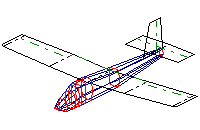
TwinStar ND twin-motor electric by Multiplex®.
>download
(--, 1970-01-01, 166)
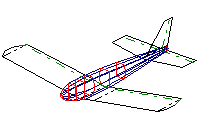
Junior Skylark by Goldberg®.
>download
(--, 1970-01-01, 839)
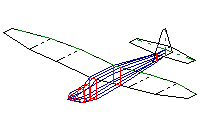
Rascal electric by SIG.
>download
(--, 1970-01-01, 1039)
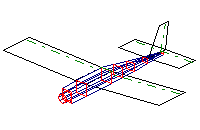
VEBF beginner model (1967 Engel catalog).
>download
(--, 1970-01-01, 696)
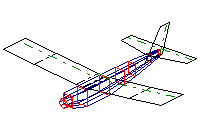
FoolProof beginner model (1967 Engel catalog).
>download
(--, 1970-01-01, 606)
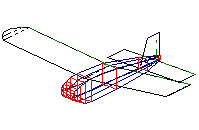
Separator (Class I) by Ben Harr / Charley Barron.
>download
(--, 1970-01-01, 748)
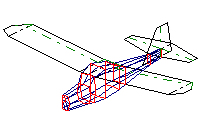
Auster Aiglet Trainer by Karl-Heinz Denzin (Hegi).
>download
(--, 1970-01-01, 873)
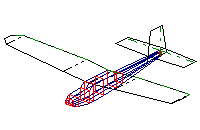
Taxi by Graupner®.
>download
(--, 1970-01-01, 1058)
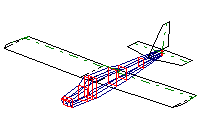
Calmato 40 Trainer by Kyosho®.
>download
(--, 1970-01-01, 1105)
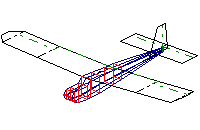
original (6ft) Telemaster by Karl-Heinz Denzin / Alexander Engel (1973).
>download
(--, 1970-01-01, 26)
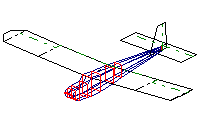
Senior Telemaster by Karl-Heinz Denzin / Alexander Engel (1973).
>download
(--, 1970-01-01, 764)
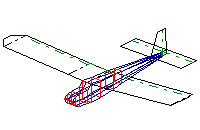
Senior Telemaster by Joe Bridi / Hobby Lobby / RCM magazine (1975).
>download
(--, 1970-01-01, 812)
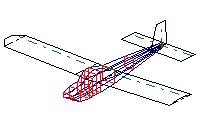
Senior Telemaster Plus by Hobby Lobby, now Hobby Express (2011).
(Measured moments of inertia.)
>download
(--, 1970-01-01, 1022)
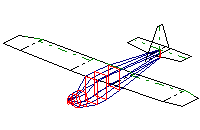
Piper Cub by Goldberg®.
>download
(--, 1970-01-01, 1014)
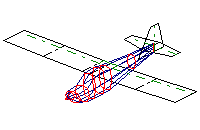
Christen A-1 Husky scaled 1:5 by Graupner®.
>download
(--, 1970-01-01, 824)
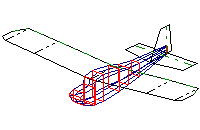
Smog Hog by Howard Bonner.
>download
(--, 1970-01-01, 641)
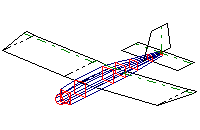
Das Ugly Stik by Phil Kraft.
>download
(--, 1970-01-01, 1424)
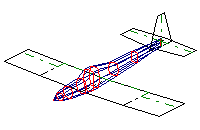
Kwik-Fli Mark I, II, III, IV, Flea Fly, and Bar-Fli, all by Phil Kraft.
>download
(--, 1970-01-01, 1285)
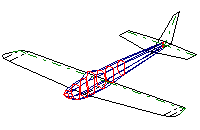
Taurus by Ed Kazmirski (Top Flite).
>download
(--, 1970-01-01, 851)
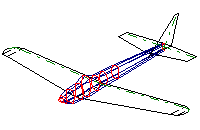
Taurus 2 by Ed Kazmirski.
>download
(--, 1970-01-01, 832)
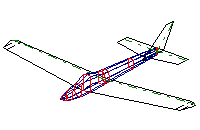
Simla by Ed Kazmirski.
>download
(--, 1970-01-01, 908)
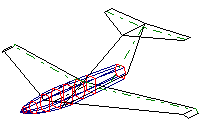
TBX-1 by Tom Brett (1965).
See discussion about his models
at RC Universe.
>download
(--, 1970-01-01, 174)
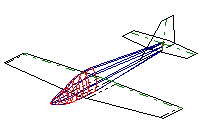
Ultra Sport 40 by Great Planes®.
>download
(--, 1970-01-01, 1013)
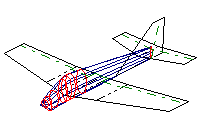
Brushfire by Ken Bonnema.
>download
(--, 1970-01-01, 921)
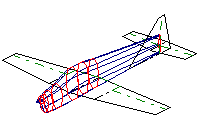
Intégral by ZNLINE.
>download
(--, 1970-01-01, 827)
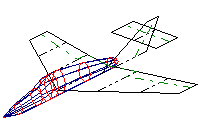
BVM KingCat.
>download
(--, 1970-01-01, 821)
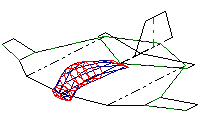
Vought V-173 as a model, only some estimates expected, but A.C. Calculator data
also included.
>download
(--, 1970-01-01, 1445)
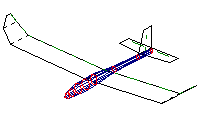
Pedro electric motorglider by Graupner®.
(Measured moments of inertia.)
>download
(--, 1970-01-01, 2087)
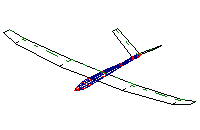
Thermik-Star electric thermal glider by CHK.
(Measured moments of inertia.)
>download
(--, 1970-01-01, 2191)
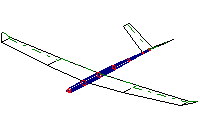
Ariane V10 F5B 10-cell-class hotliner by Team Ariane.
>download
(--, 1970-01-01, 1292)
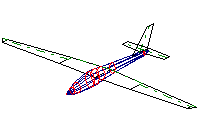
MDM-1 Fox aerobatic glider as a model scaled 1:3.5.
>download
(--, 1970-01-01, 1627)
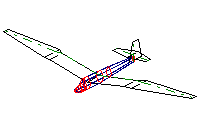
Göppingen Gö 3 Minimoa as a model scaled 1:3.5.
>download
(--, 1970-01-01, 812)
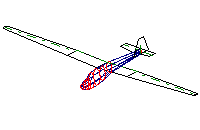
Scheibe L-Spatz 55 as a model scaled 1:3.5.
>download
(--, 1970-01-01, 715)
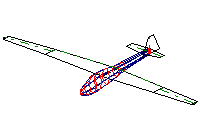
Scheibe Bergfalke II/55 as a model scaled 1:3.5.
>download
(--, 1970-01-01, 819)
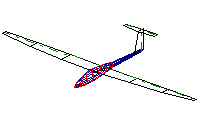
DG Flugzeugbau DG-1000 scaled 1:5.4 by HF-Modell.
>download
(--, 1970-01-01, 180)
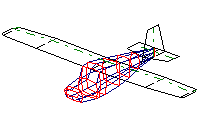
Scheibe SF 23 C Sperling as a model scaled 1:3.5.
>download
(--, 1970-01-01, 1040)
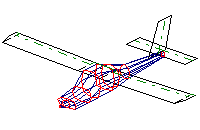
PZL Wilga 2000 in 1:3.5 scale by Rödelmodell.
>download
(--, 1970-01-01, 1311)
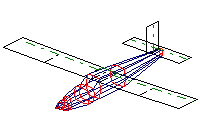
Pilatus PC-6 Turbo Porter as a model in 1:3.5 scale.
>download
(--, 1970-01-01, 1014)
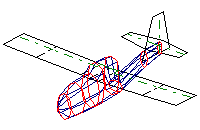
Republic RC-3 Seabee as a model in 1:3.5 scale.
>download
(--, 1970-01-01, 1009)
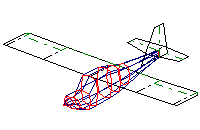
Bellanca Super Decathlon in 1:3.9 scale by Exclusiv-Modellbau.
>download
(--, 1970-01-01, 954)
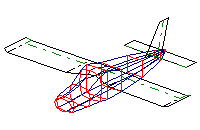
Boelkow Bo 208 A Junior as a model in 1:3 scale.
>download
(--, 1970-01-01, 998)
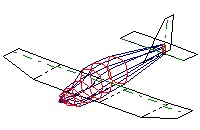
Robin DR 400 in 1:4 scale by Rödelmodell.
>download
(--, 1970-01-01, 1042)
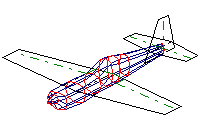
Katana S 3D model by Exclusiv Modellbau.
>download
(--, 1970-01-01, 1033)
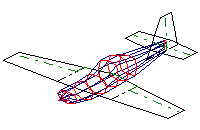
Terzi T-30 Katana as a model in 1:2.5 scale.
>download
(--, 1970-01-01, 947)
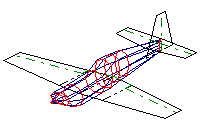
Extra EA-300S as a model in 1:2.3 scale.
>download
(--, 1970-01-01, 1013)
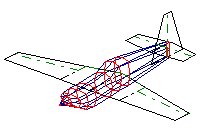
Zivko EDGE 540 as a model in 1:2.3 scale.
>download
(--, 1970-01-01, 1065)
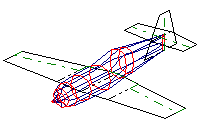
Sukhoi Su-26M as a model in 1:2.3 scale.
>download
(--, 1970-01-01, 1030)
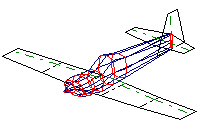
Mudry CAP 21 as a model scaled 1:3.5.
>download
(--, 1970-01-01, 878)
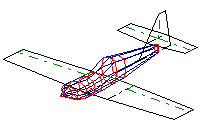
Zlin Z-50LS in 1:4 scale by Airfly.
>download
(--, 1970-01-01, 994)
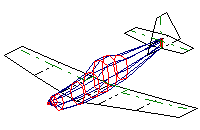
Zlin Z-526AFS in 1:2.95 scale by Aeroflug / Skygate Collection.
>download
(--, 1970-01-01, 1013)
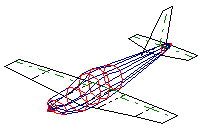
SIAI-Marchetti SF-260 in 1:3 scale by Aeroflug.
>download
(--, 1970-01-01, 1130)
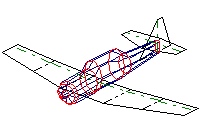
North American AT-6 Texan in 1:5 scale by Nick Ziroli.
>download
(--, 1970-01-01, 974)
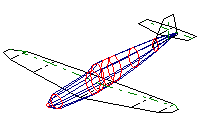
Messerschmitt Bf 109 G in 1:5 scale by Rödelmodell.
>download
(--, 1970-01-01, 1067)
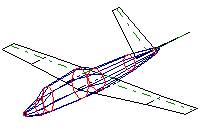
Fouga CM.170 Magister as a model scaled 1:3.5.
>download
(--, 1970-01-01, 1052)
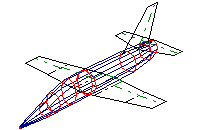
AERO L-39 in 1:5 scale by Airworld.
>download
(--, 1970-01-01, 1036)
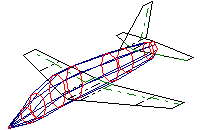
BAe Hawk T.1 in 1:4.5 scale by Airworld.
>download
(--, 1970-01-01, 1112)
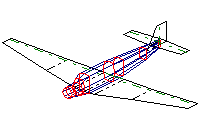
Junkers Ju 52/3m as a model in 1:6.5 scale.
>download
(--, 1970-01-01, 738)
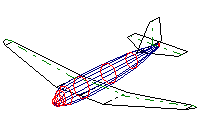
Douglas DC-3 scaled 1:8 by Nick Ziroli.
>download
(--, 1970-01-01, 870)
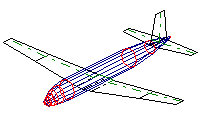
Douglas DC-6 as a model scaled 1:8.
>download
(--, 1970-01-01, 786)
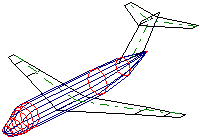
Douglas DC-9-15 as a model scaled 1:8.
>download
(--, 1970-01-01, 1072)
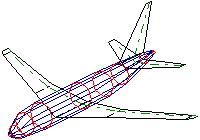
Airbus A318-111 as a model in 1:10 and 1:16 scale.
>download
(--, 1970-01-01, 1306)
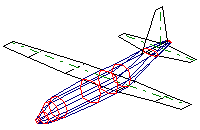
Lockheed C-130 Hercules as a model in 1:6.5 scale.
>download
(--, 1970-01-01, 839)
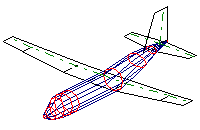
Transall C-160 as a model in 1:6.5 scale.
>download
(--, 1970-01-01, 896)
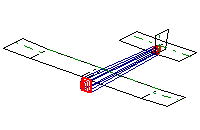
Sikorsky S-22 Ilya Muromets as a model scaled 1:6.
Equivalent monoplane, see
RC Universe thread.
>download
(--, 1970-01-01, 611)
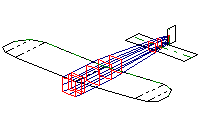
Bleriot XI as a model scaled 1:2.9.
>download
(--, 1970-01-01, 25)
Propeller Calculations with JavaProp
The propellers of my models were photographed with a digital camera. Using the pictures, the program 'PropellerScanner' by Martin Hepperle derived the geometry data. The program 'JavaProp' by Martin Hepperle calculated the propeller coefficients from the geometry. The values are stored in a file named 'MultiAnalyse.txt' and offered here together with all files needed to review the process.
![]() Günther propeller 17.5x16 cm for park- and slowflyers.
Günther propeller 17.5x16 cm for park- and slowflyers.
>download
(--, 1970-01-01, 1938)
![]() Graupner® Super Nylon 7x5" classic.
Graupner® Super Nylon 7x5" classic.
>Download
(--, 1970-01-01, 1235)
![]() APC® 9x6" SlowFly for park- and slowflyers.
APC® 9x6" SlowFly for park- and slowflyers.
>download
(--, 1970-01-01, 1471)
![]() APC® 11x7" SlowFly for park- and slowflyers.
APC® 11x7" SlowFly for park- and slowflyers.
>download
(--, 1970-01-01, 1663)
![]() APC® 17x10" E for electric drives.
APC® 17x10" E for electric drives.
>download
(--, 1970-01-01, 1052)
![]() aero-naut® CAMcarbon folding prop 14x8" for gliders.
aero-naut® CAMcarbon folding prop 14x8" for gliders.
>download
(--, 1970-01-01, 1184)
![]() Graupner® CFK folding prop 20x12" for gliders.
Graupner® CFK folding prop 20x12" for gliders.
>download
(--, 1970-01-01, 1280)
Airfoil Polar Calculations with JavaFoil
The airfoil geometry data are retrieved from Michael S. Selig's UIUC Airfoil Data Site (ADS). The polars were calculated with 'JavaFoil' by Martin Hepperle. Additional measured airfoil performance data came from Hiroshi Takeushi's now defunct NASG Airfoil Database and the UIUC Low-Speed Airfoil Tests (LSAT) of the UIUC Applied Aerodynamics Group. All these airfoil data are available here as far as they are freely available elsewhere.
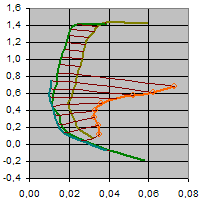
Anderson SPICA (11.73% thickness, 4.62% camber, straight lower surface).
>download
(--, 1970-01-01, 2345)
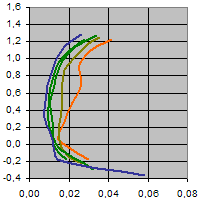
Selig/Donovan SD7037 (9.21% thickness, 2.99% camber, concave lower surface).
>download
(--, 1970-01-01, 1516)
Electric Drive Calculations
The motor coefficients are derived from catalog data and measurements. The propeller coefficients from 'JavaProp' are used to calculate the data of the whole drive. In some cases also flight performance data as well as climb and glide polars are calculated. The spreadsheets with all formulas are available here. If you find any error please drop me an e-mail.
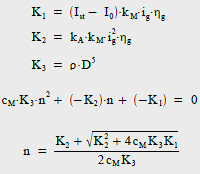
Formulas (and text in English):
Equations for a simplified drive model including propeller.
Derivation of basic solution for rpm dependent on flight speed.
Equations for characteristic rotational speeds and their ratios.
Diagrams illustrating the motor/gear combination's characteristics.
Diagrams illustrating the propeller's characteristics.
Diagrams illustrating the drive's characteristics.
>download
(--, 1970-01-01, 1730)
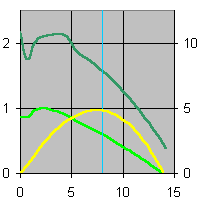
Brummi:
Permax 400 6 V, 2.3:1 gear, Günther propeller 6.9x6.3";
AXI 2208/34, APC 9x6" SlowFly, 2s LiPo;
AXI 2212/26, APC 9x6" SlowFly, 2s LiPo;
AXI 2212/34, APC 9x6" SlowFly, 3s LiPo.
including performance calculations and polars.
>download
(--, 1970-01-01, 2136)
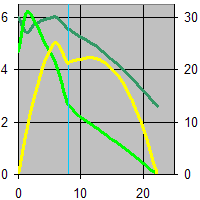
Miss 2:
Speed 400 6 V, 1.85:1 gear, 9x5" CAM folding propeller, 7 cells NiCd 500 mAh;
Speed 400 6 V, 2.33:1 gear, 9x5" Slim propeller, 8 cells NiMH 1100 mAh;
Speed 400 7.2 V, 2.33:1 gear, 9x5" Slim propeller, 8 cells NiCd 1300 mAh.
Including performance calculations and polars.
>download
(--, 1970-01-01, 1106)
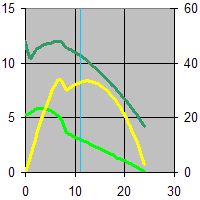
threedee400:
Acro Speed 280BB 6 V, 5.0:1 gear, APC 9x6" SlowFly (AcroDrive 350+BB);
Permax 480 7.2 V, 3.0:1 gear, APC 11x7" SlowFly;
AXI 2212/34, APC 11x7"/11x4.7"/10x7"/9x7.5" SlowFly.
>download
(--, 1970-01-01, 1226)
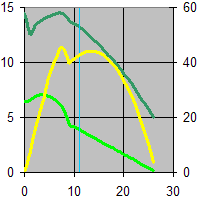
Jitterbug:
AXI 2808/24, 2212/26, 2212/34;
APC 12x6" SlowFly, 11x7" SlowFly, 11x5.5" Electric, 11x4.7" SlowFly.
>download
(--, 1970-01-01, 1405)
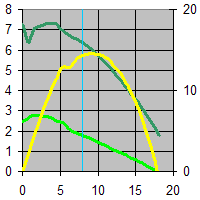
GWS Slow Stick:
EM300 7.2 V, 6.6:1 gear, 11x8" SlowFly (EPS300C drive).
>download
(--, 1970-01-01, 1151)
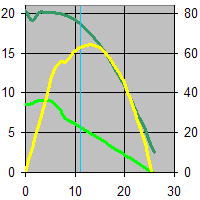
Thermik-Star:
Plettenberg HP 200/25/5, 4.4:1 gear, CAMcarbon 14x8".
Including performance calculations and polars.
>download
(--, 1970-01-01, 1949)
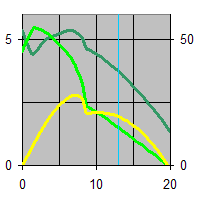
Race-E:
AXI 2808/26, APC 8x3.8" SlowFly, 2s LiPo;
AXI 2808/34, APC 9x6" SlowFly, 2s LiPo;
AXI 2808/34, APC 9x4.7" SlowFly, 3s LiPo.
>download
(--, 1970-01-01, 1368)
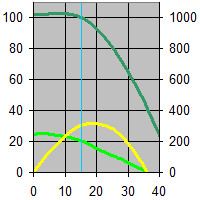
Senior Telemaster Plus:
Hype ALPHA AL50-360L, APC 17x10" E, 5s LiPo;
Hype ALPHA AL50-360L, APC 17x12" E, 5s LiFePo;
Hype ALPHA AL50-360L, APC 17x12" E, 4s LiPo;
Hype ALPHA AL50-360L, APC 17x12" E, 4s LiPo, APC calculated coefficients;
Hype ALPHA AL50-360L, APC 17x12" E, 4s LiPo, Michael Selig measured coefficients.
Including performance calculations and polars.
>download
(--, 1970-01-01, 1415)
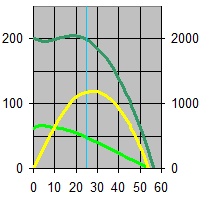
ZNLINE Intégral:
AXI 5330/F3A, AXI 20x13" F3A Carbon, 10s LiPo.
>download
(--, 1970-01-01, 854)
Glow Engine Drive Calculations
The engine performance data are taken from reviews. The propeller coefficients from 'JavaProp' are used to calculate the data of the whole drive at WOT. The spreadsheets with all formulas are available here.
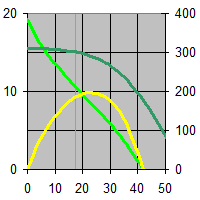
Smog Hog:
Fox 35 Stunt, TopFlite 11x6" wood (approximated);
Fox 35 Stunt, TopFlite 10x6" wood (approximated).
>download
(--, 1970-01-01, 863)
Instructions for Installation:
Download the installer package to a folder on your hard disk were it can remain!
When you run it, you can select models and sceneries for training. There are predefined selections: for basic, intermediate, and advanced training; limited or extended choice of models and sceneries; or simply full selection. You can always select each and any model or scenery directly by ticking it, that’s called custom installation then.
When you proceed now, the installer will show you a list of more installer packages that have to be downloaded first in order to install the selected models and sceneries. These packages are all ticked already, just for your information, so you can click the Install button right away.
A lot will be going on now, but virtually nothing is shown in the installer window. But you can have Windows Explorer running behind the installer window and displaying the folder where the trainer-installer package resides. Then you will see the additional installer packages showing up after they have been automatically downloaded. You still can’t see that they are automatically run then in order to install the selected models and sceneries. Either way, just patiently wait until disk activity ends!
Now you will find the installed models in the Model Selection (F2 key) of REFLEX XTR² in the “Aircraft | Trainer” branch. This “branch” or “group” is supplemental to the groups in which models are actually stored. It just pools the trainer models so you can easily find them, and it holds just “links” to them.
All models, that is variants of a type, are stored in their own groups, named after the model’s or the original’s manufacturer or, in case of my models, in sub-groups of “BE”, named like the model type. You can find and select them for simulation there (F2 key, “Aircraft”) as well, just under slightly different names.
All installer packages downloaded to your hard disk will stay in place. One way to run them again is double-clicking them in Windows Explorer. But there should be now a folder named REFLEX in the Windows menu "Start | All Apps". It holds uninstall entries for all installer packages, re-select entries for many of them, as well as links to model descriptions for several of them. So you may easily read about a model, modify your selection of variants, or remove it completely. You can save that for later, though.
For now, just think about running the trainer-installer package again. You will want to do that when you are learning to fly airplanes and want to step-up, for instance from basic to intermediate training, or to extend your model selection. In the former case, the previously installed models are removed from the “Trainer” group and the newly selected ones installed instead. In the latter case, the newly selected ones are just added. You can also add or remove models to or from the group by ticking or unticking them, respectively.
Models you remove from the “Trainer” group by running the trainer-installer package again will remain in their own groups. Even if you substitute variants of a model by other variants, the variants removed from the “Trainer” group will remain in the model's own group as well. There you may install more variants of this model by running its own installer package but – as said above – you can save that for later.
For sceneries, there is no supplemental group with “links”. In the Scenery Selection (F3 key) of REFLEX XTR², you can find them in their respective country groups, which are Austria, the Czech Republic, and Germany for the sceneries suggested here. Only one of them has variants to select.
If you are ready now, you may click on the link below to download the trainer-installer package. Your browser should show a dialog box where you can choose an appropriate folder on your hard disk to store the installer package. If it doesn’t and stores into your Downloads folder by default, you can either move the downloaded installer file in Windows Explorer or just leave it in the Downloads folder. In this case, make sure that you do not remove it later.
You may run the installer directly from your browser (from where it usually displays downloaded files), if you are happy with just waiting until the installer has done its job. But if you like to watch how the additional installer packages are downloaded (like described above), you should run Windows Explorer, display the chosen folder, and run the installer package from there (by double-click).
Download the trainer airplane installer package here.
(You can always see these instructions again later by clicking "download package" on my Downloads page. Enjoy!)
Instructions for Installation:
Download the installer package to a folder on your hard disk were it can remain!
When you run it, you can select models and sceneries for training. There are two predefined selections: compact or full. You can always select each and any model or scenery directly by ticking it, that’s called custom installation then.
When you proceed now, the installer will show you a list of more installer packages that have to be downloaded first in order to install the selected models and sceneries. These packages are all ticked already, just for your information, so you can click the Install button right away.
A lot will be going on now, but virtually nothing is shown in the installer window. But you can have Windows Explorer running behind the installer window and displaying the folder where the trainer-installer package resides. Then you will see the additional installer packages showing up after they have been automatically downloaded. You still can’t see that they are automatically run then in order to install the selected models and sceneries. Either way, just patiently wait until disk activity ends!
Now you will find the installed models in the Model Selection (F2 key) of REFLEX XTR² in the “Heli-/Multicopter | Trainer” branch. This “branch” or “group” is supplemental to the groups in which models are actually stored. It just pools the trainer models so you can easily find them, and it holds just “links” to them.
All models, that is variants of a type, are stored in their own groups, named after the model’s or the original’s manufacturer. You can find and select them for simulation there (F2 key, “Heli-/Multicopter”) as well, just under slightly different names.
All installer packages downloaded to your hard disk will stay in place. One way to run them again is double-clicking them in Windows Explorer. But there should be now a folder named REFLEX in the Windows menu "Start | All Apps". It holds uninstall entries for all installer packages as well as re-select entries for many of them. So you may easily read about a model, modify your selection of variants, or remove it completely. You can save that for later, though.
For now, just think about running the trainer-installer package again. You will want to do that when you are learning to fly helicopters and want to extend your model selection. The newly selected models are added to the “Trainer” group then. You can also add or remove models to or from the group by ticking or unticking them, respectively.
Models you remove from the “Trainer” group by running the trainer-installer package again will remain in their own groups. Even if you substitute variants of a model by other variants, the variants removed from the “Trainer” group will remain in the model's own group as well. There you may install more variants of this model by running its own installer package but – as said above – you can save that for later.
For sceneries, there is no supplemental group with “links”. In the Scenery Selection (F3 key) of REFLEX XTR², you can find them in their respective country groups, which are Austria and Germany for the sceneries suggested here. Only two of them have variants to select.
If you are ready now, you may click on the link below to download the trainer-installer package. Your browser should show a dialog box where you can choose an appropriate folder on your hard disk to store the installer package. If it doesn’t and stores into your Downloads folder by default, you can either move the downloaded installer file in Windows Explorer or just leave it in the Downloads folder. In this case, make sure that you do not remove it later.
You may run the installer directly from your browser (from where it usually displays downloaded files), if you are happy with just waiting until the installer has done its job. But if you like to watch how the additional installer packages are downloaded (like described above), you should run Windows Explorer, display the chosen folder, and run the installer package from there (by double-click).
Download the trainer helicopter installer package here.
(You can always see these instructions again later by clicking "download package" on my Downloads page. Enjoy!)
Instructions for Installation:
Download the installer package to a folder on your hard disk were it can remain!
When you run it, you can select scale models scaled 1:3.5. There are two predefined selections: compact or full. You can always select each and any model directly by ticking it, that’s called custom installation then.
When you proceed now, the installer will show you a list of more installer packages that have to be downloaded first in order to install the selected models. These packages are all ticked already, just for your information, so you can click the Install button right away.
A lot will be going on now, but virtually nothing is shown in the installer window. But you can have Windows Explorer running behind the installer window and displaying the folder where the Scale35 installer package resides. Then you will see the additional installer packages showing up after they have been automatically downloaded. You still can’t see that they are automatically run then in order to install the selected models. Either way, just patiently wait until disk activity ends!
Now you will find the installed models in the Model Selection (F2 key) of REFLEX XTR² in the “Aircraft | BE | Scale 3.5” branch. This “branch” or “group” is supplemental to the groups in which the models are actually stored. It just pools the Scale 3.5 models so you can easily find them, and it holds just “links” to them.
All models, that is variants of a type, are stored in their own groups, named after the original’s manufacturer or, in case of my models, in sub-groups of “BE”, named like the type. You can find and select them for simulation there (F2 key, “Aircraft”) as well, just under slightly different names.
All installer packages downloaded to your hard disk will stay in place. One way to run them again is double-clicking them in Windows Explorer. But there should be now a folder named REFLEX in the Windows menu "Start | All Apps". It holds uninstall entries for all installer packages, re-select entries for many of them, as well as links to model descriptions for several of them. So you may easily read about a model, modify your selection of variants, or remove it completely.
Also the Scale 3.5 installer package can be run again to modify your model selection in the “Scale 3.5” group. You may add or remove models to/from the group by ticking or unticking them, respectively.
Models you remove from the “Scale 3.5” group by running the Scale 3.5 installer package again will remain in their own groups. Most of the models have more variants which you can install in their own group by running their own installer package.
If you are ready now, you may click on the link below to download the Scale 3.5 installer package. Your browser should show a dialog box where you can choose an appropriate folder on your hard disk to store the installer package. If it doesn’t and stores into your Downloads folder by default, you can either move the downloaded installer file in Windows Explorer or just leave it in the Downloads folder. In this case, make sure that you do not remove it later.
You may run the installer directly from your browser (from where it usually displays downloaded files), if you are happy with just waiting until the installer has done its job. But if you like to watch how the additional installer packages are downloaded (like described above), you should run Windows Explorer, display the chosen folder, and run the installer package from there (by double-click).
Download the 1:3.5 scale models installer package here.
(You can always see these instructions again later by clicking "download package" on my Downloads page. Enjoy!)
Installing the model manager:
Download the app to a folder on your hard disk were it can remain! If you already have installer packages for models, this app should go into the same folder. Then it can manage the existing models and any further installer packages will go into this folder as well.
When you run the app, there will be instructions how to use it and, finally, how to run (find) it again (or even remove it).
When you have clicked "Install" (only once!) in the app, there may be a silent download but then the downloaded installer program should show up. There you have to select variants or just confirm until that installation ends. This procedure will be repeated for all models which are to be installed in the first place or for whom other variants have to be selected. Finally, the model manager will show another dialog page to end the whole process.
You will find the installed models in the Model Selection (F2 key) of REFLEX XTR² in their respective manufacturer groups, either model manufacturer or (in case of scale models) full-size manufacturer, or in my group "BE" and subgroups. These “groups” as well as the models in them are listed in alphabetical order.
All installer packages downloaded to your hard disk will stay in place. You may run the model manager again (via its app menu entry) in order to add models to your REFLEX XTR² installation or remove some from it. Re-installing models does not require additional downloads. Most of the installer packages can also be run again to add or remove variants of the respective model (for instance different paint scheme, different scale, different drive).
If you are ready now, you may click on the link below to download the model manager. Your browser should show a dialog box where you can choose an appropriate folder on your hard disk to store it. If it doesn’t and stores into your Downloads folder by default, you should by all means move the downloaded app file in Windows Explorer – before you run it – to the folder where you store the model installer packages.
If the app has been downloaded into the right folder right away, you may run it directly from your browser (from where it usually displays downloaded files).
Download the model manager app here.
(You can always see these instructions again later by clicking "download manager" on my Downloads page. Enjoy!)
Installing the scenery manager:
Download the app to a folder on your hard disk were it can remain! If you already have installer packages for sceneries, this app should go into the same folder. Then it can manage the existing sceneries and any further installer packages will go into this folder as well.
When you run the app, there will be instructions how to use it and, finally, how to run (find) it again (or even remove it).
When you have clicked "Install" (only once!) in the app, a lot will be going on but nothing is shown in the app window. But you can have Windows Explorer running behind the scenery manager and displaying the folder where the scenery installer packages reside. Then you will see additional installer packages showing up if any have been automatically downloaded. You still can’t see when they are automatically run in order to install the selected sceneries. Either way, just patiently wait until disk activity ends and a new scenery manager page appears!
You will find the installed sceneries in the Scenery Selection (F3 key) of REFLEX XTR² in their respective country groups, like Austria or Germany. These “groups” as well as the sceneries in them are listed in alphabetical order.
All installer packages downloaded to your hard disk will stay in place. You may run the scenery manager again (via its app menu entry) in order to add sceneries to your REFLEX XTR² installation or remove some from it. Re-installing sceneries does not require additional downloads.
If you are ready now, you may click on the link below to download the scenery manager. Your browser should show a dialog box where you can choose an appropriate folder on your hard disk to store it. If it doesn’t and stores into your Downloads folder by default, you should by all means move the downloaded app file in Windows Explorer – before you run it – to the folder where you store the scenery installer packages.
If the app has been downloaded into the right folder right away, you may run it directly from your browser (from where it usually displays downloaded files), that is if you are happy with just waiting until the scenery manager has done its job. But if you like to watch how additional installer packages are downloaded (like described above), you should run Windows Explorer, display the chosen folder, and run the scenery manager from there (by double-click).
Download the scenery manager app here.
(You can always see these instructions again later by clicking "download manager" on my Downloads page. Enjoy!)